
-j±£ü-l hotb4Sle
(Eleme ary- 1 te
Sarah Johnson &
Jane Myles
BblJIO>Kel-lO rpynnoÿl vk.com/create_your_english
Timesaver London!
(Elementary - Intermediate)
Sarah Johnson and Jane Myles
BblJIOxeHO rpynnoV1 vk.com/createyour_english
![]()
Elementary (Students with up to 1 year of English)
![]()
|
This is London: map |
prepositions: between, near; numbers |
Listening |
6 |
|
Arriving in London |
compass points: north, south, east, west; airport vocabulary |
|
8 |
|
London Transport |
numbers; buying a ticket |
Reading and speaking |
10 |
|
Going by Tube |
present simple; colours; prepositions; between, along, in, through, near, under |
Reading; colouring |
12 |
|
The London Eye |
numbers; measurements; prices |
Reading and speaking |
|
|
The Tower of London |
numbers; has got |
Reading and writing |
16 |
|
The River Thames |
prepositions |
Listening and following a route |
18 |
|
London Football Clubs |
superlatives; personal statistics; chants |
Reading and comparing statistics |
20 |
|
Madame Tussauds |
looks like; possessives |
|
22 |
|
Buckingham Palace |
rooms and furniture vocabulary |
Writing about your home |
24 |
|
The London Butterfly House |
colours; modal can |
Reading; colouring |
25 |
|
Hamleys |
ordinal numbers; Where is... ? / Where are... ? |
Reading and role play |
26 |
|
Harrods |
modal: can; asking for a refund |
Speaking; making a complaint |
28 |
|
London Markets |
superlatives; How much is / are... ? Can you... ? |
Demonstrating physical skills |
30 |
|
London's Theatreland |
1st conditional; booking a ticket |
Speaking; role play |
32 |
|
Dogs in London |
basic descriptions; has got |
Role play; dialogues |
34 |
|
Eating Out: London Food |
ordering food in a restaurant; nationalities |
Reading and speaking |
36 |
e Pre-intermediate (Students with 1-2 years of English)
![]()
Everyday Londoners statistics; enquiring about a job on
Writing an e-mail home; 38 the telephone Speaking: a job interview ![]()
|
The Boat Race |
comparatives; superlatives; ago; have to, must |
Reading; gap fill |
40 |
|
Wimbledon: The Home of Tennis |
tennis vocabulary; must / mustn't |
Reading; multiple choice exercise |
42 |
|
Theme Parks Around London |
must; 1st conditional; some, any, no, lots, a few |
Reading; gap fill |
44 |
|
City Animals |
present simple tense; superlatives |
Speaking; ranking |
46 |
TIMESAVER LONDON! MARY GLASGOW MAGAZINES, AN IMPRINT OF SCHOLASTIC INC.
TIMESAVER LONDON!
|
The London Aquarium |
can; adverbs in -ly; reflexives; like + -ing |
Reading; gap fill |
47 |
|
|
London Zoo |
past simple; multi-words verbs |
Reading; maze |
48 |
|
|
EastEnders |
talking about towns, buildings, facilities |
Writing and group work: creating a TV script |
50 |
|
|
The London Marathon |
daily routine |
Reading + fitness quiz |
52 |
|
|
Notting Hill and the Carnival |
going to future |
Writing + planning a visit to the Carnival |
54 |
|
|
Intermediate (Students with 2-3 years of English) |
|
|
||
|
vppiq |
STRUCTURES L FUNCTIONS |
|
|
|
|
Leicester Square: London cinemas |
a great deal, a couple of, plenty of, a few several, a bit of; allowed to |
Writing + identifying celebrities |
56 |
|
|
Music in London |
will / going to future; ordinal numbers |
Reading; gap fill |
57 |
|
|
Party in the Park |
past perfect; too + adj. + to do something, not + adj enough to do something |
Reading |
58 |
|
|
The Lord Mayor's Show |
passives; numbers and dates |
Reading; Mathmatics |
59 |
|
|
Legendary Londoners: Dick Whittington, Sherlock Holmes and Samuel Pepys |
question tags; past tense; making conclusions using must be, can't be, must have been, can't have been |
Reading; writing; deduction |
60 |
|
|
Cockney Rhyming Slang |
London slang; body vocabulary |
Reading |
62 |
|
|
The British Museum |
compound adjectives |
Reading: gap-fill |
63 |
|
|
Hampton Court |
2nd conditional; past tense |
Logic puzzle; problem-solving |
64 |
|
|
The London Dungeon |
passives |
Reading; multiple choice |
66 |
|
|
Westminster and the Houses of Parliament |
past simple; multi-word verbs |
Reading: gap-fill |
68 |
|
|
Guy Fawkes and The Gunpowder Plot |
multi-word verbs; simple past |
Reading + multiple choice |
69 |
|
|
London Parks |
used to |
Reading; gap fill |
70 |
|
|
Art in London |
passives |
Reading |
71 |
|
|
Pubs and Clubs |
allowed to; irregular past tense |
Reading; gap fill |
72 |
|
|
Greenwich |
telling the time |
Reading; code-breaking |
73 |
|
|
Charles Dickens |
past tense; used to |
Reading; crossword |
74 |
|
Teacher's
Answer Section
TIMESAVER LONDON! C MARY GLASGOW MAGAZINES, AN IMPRINT OF SCHOLASTIC INC.
![]()
Teacher's Notes and
Background Information
![]()
Key to symbols:
O Elementary
(students with up to 1 year of English)
Pre-intermediate
(students with 1-2 years of English)
Intermediate
(students with 2-3 years of English)
The clock symbol at the top of each new topic indicates approximately how many minutes the reading section and extension activity should take.
![]()
Most of the pages in this book will need no further explanation. The elementary pages contain interactive sections of text alongside short reading passages. In the later pre-intermediate and intermediate pages, there is usually a reading page on the left and an exploitation page on the right-hand side, but occasionally a onepage topic which contains combined factual text and an integrated exercise.
The language used in the book extends from elementary level through to intermediate. In some cases, the grammatical structures will be simple, but the vocabulary may be a bit more obscure which is why you may find a page classified under pre-intermediate rather than elementary level.
Follow-up projects
Where possible we have
included website addresses so ![]() that you can do further research. However,
as always, please be warned that although the sites were checked before going
to press, the nature of websites and their content can change or the entire
site may become inactive.
that you can do further research. However,
as always, please be warned that although the sites were checked before going
to press, the nature of websites and their content can change or the entire
site may become inactive.
The vocabulary check lists
You will notice that there are short vocabulary check lists accompanying each topic. We suggest that before you begin a topic, you photocopy the word check list or copy it onto the board to see if students can predict what they think the topic is going to be. Take a vote to see what the majority of students think it is. If there are several different suggestions, see if the students representing one opinion can persuade others from a
TIMESAVER LONDON! © MARY GLASGOW MAGAZINES, AN IMPRINT OF SCHOLASTIC INC.
different group by giving reasons for certain words being in the list. At this stage they don't have to translate all the words in the list. The meanings of some of the words will be deduced from their context in the reading passage.
You can allocate one word from the check list to each student in advance of the lesson, and then get them to explain to the rest of the class what it means and how it is pronounced.
On pages 6 & 7 you will find a rough map of London which tries to include as many of the locations mentioned in this book as possible. Those which are too far from the centre are indicated with directional arrows.
Using the key to the map (on page 5), you can practise numbers as well as teaching your students a lot of basic London geography.
Ask, for example:
Can you see number 4 on the map?
Which other numbers are near it? (5 and 6) Which two places/numbers is it between?
Students can then guess what they think it might be.
Alternatively, you could ask:
What number do you think the Tower of London is? and see how many students get it right.
You can enlarge the map on a photocopier and this will then give students a bit more space to write in the names of the places next to the numbers if you call them out as a dictation exercise.
As further extension work, get students to work with actual maps of London and see what other landmarks they can identify and add to their own photocopied maps, eg 10, Downing Street, the home of the Prime Minister, Covent Garden, Baker Street, or Waterloo Station.
Once you have done quite a lot of pages from the book, you could ask students to look at their copies of the map and ask people to talk for a few minutes about 'number...' on the map, since they will have learned quite a lot of facts by doing the activities in this book, eg, Anna, can you talk for five minutes about number 3?
If the nominated student is struggling to remember or to put their thoughts into English, you can ask for other volunteers to help them out.
|
1 2 3 4 5 6 7 8 9 10 11 12 13 14 15 16 17 18 |
Heathrow Airport The London Eye The Tower of London Big Ben Houses of Parliament Westminster Abbey The Natural History Museum Madame Tussaud's Buckingham Palace Tate Modern Tate Britain The National Gallery Trafalgar Square Hamleys Harrods Portobello Road Piccadilly Circus Leicester Square |
19 20 21 22 23 24 25 26 27 28 29 30 31 32 33 34 35 36 37 |
Oxford Street Chinatown Wimbledon Battersea London Aquarium London Zoo Regent's Park Hyde Park Richmond Park St Paul's Cathedral Notting Hill The British Museum Hampton Court The London Dungeon The Science Museum Greenwich Royal Albert Hall Festival Hall HMS Belfast |
Background information
History
The history of London as a permanent settlement stretches back almost two thousand years. The city has no known founder. Shortly after the Roman conquest of 43 AD, the invaders grasped the strategic significance of the River Thames, slicing through the flattest, most fertile portion of their new province, its estuary providing easy access to the European mainland. Londinium, as it was then known, became a thriving city.
With the collapse of Roman administration, Londinium was abandoned in the fifth century. The invading Anglo-Saxons were farmers who gradually pushed the native Romano-British westwards. They had no taste for city life and preferred to found villages which are now
London's suburbs or satellites such as Fulham, Mitcham, Ealing and Barking.
The Norman invasion of 1066 was marked by the construction of the Tower of London, which protected London Bridge from raiders coming upstream and was built to overawe its inhabitants as a symbol and embodiment of royal power.
London was devastated by the epidemic of bubonic plague, known as the Black Death, which carried off a third of the population in 1348-9.
The population of London tripled under the Tudors, making it the greatest city in Britain — almost a hundred times more populous than the Stratford-on-Avon in which Shakespeare grew up before coming to the
Globe Theatre as actor-manager. Two
devastating events took place during the reign of Charles Il — the Great Plague
in 1665, and the Great Fire of London which destroyed many of the city's most
beautiful buildings a year later in 1666. Although half the city was destroyed,
only six people were injured. ![]()
By 1700, London's population had passed the halfmillion mark, ranking it with Paris and Naples as one of Europe's three largest cities. However, with the Industrial Revolution in the nineteenth century, squalor and poverty accompanied its rapid growth. Charles Dickens chronicled much of this in his novels.
Facts and figures
Population: 7.19 million. This means that one in eight of the UK population live in London. 47% of these people are aged 16 to 44 and one in four of London's population is from an ethnic minority.
Language: Over 200 languages are spoken in London. London is a global centre for international business with over 25% of the world's largest companies having their European headquarters in London
Parks: Almost a third of London is green space or parks (many of which are Royal Parks) - more than any other city of its size in the world.
Transport: There are 20,000 licensed taxis in London, 20,000 buses and 275 underground stations.
Food and drink: There are 6,000 restaurants and 5,000 pubs and bars. The restaurants serve food from seventy different countries.
Historic buildings: London has 1 51 historic buildings and ancient monuments and 33 historic gardens. There are over 18,000 historically listed buildings in London, nearly 600 of which are Grade I listed (ie extremely important) and 21 % of which are within the borough of Westminster. There are three world heritage sites in
London: the Tower of London, Maritime Greenwich and Westminster Abbey.
Entertainment: London has over 200 museums, 500 cinema screens and 108 theatres and music halls. There are 1,500 drama groups, 600 dance groups and five symphony orchestras.
Sport: 95 golf courses, 50 athletics tracks, 2000 tennis courts, seven ice rinks, 546 swimming pools, 37 rowing clubs, 12 professional football teams, two county cricket clubs and six race courses all within an hour of London.
Tourism: In 2002, 28 million people visited for at least one night.
TIMESAVER LONDON! © MARY GLASGOW MAGAZINES, AN IMPRINT OF SCHOLASTIC INC.
BblJIOxeHO rpynnoÿl vk.com/create_your_english
This bright and stimulating map shows the main areas and landmarks of central London and its surrounding area. We have tried to include as many of the locations mentioned in Timesaver London! as possible. Those which are too far from the centre are indicated with directional arrows.
The London Uncovered! map is a great visual stimulus which
will brighten up ![]() your classroom and act as a motivating context for students as they work
through the activities in the book. It can be used in conjunction with the students'
photocopiable map on pages 6 & 7 of Timesaver London! In addition, you
might like to try the further exploitation ideas below.
your classroom and act as a motivating context for students as they work
through the activities in the book. It can be used in conjunction with the students'
photocopiable map on pages 6 & 7 of Timesaver London! In addition, you
might like to try the further exploitation ideas below.
Classwork or pairwork
Target language: Is it ... ? Can you ... ? Does it have ![]() ' Is / are there ?
' Is / are there ?
1 One student in the class or pair chooses a landmark on the map. They mustn't tell the rest of the class where it is.
2 The other students ask questions to deduce where the landmark is. Student A can only answer 'Yes' or 'No'. Give students a limit to the number of questions they can ask — eight, for example.
Note
Encourage students to use information they've learnt from Timesaver London! in their questions.
Possible questions
Is it in North / East / South / West London?
Is it near a park / the river? Is it a building?
Can you buy clothes there?
Can you see paintings there?
Can you play / watch sport there?
Directions game: Where am I?
Classwork
Target language: Cross the river / bridge. Turn left / right into Go / walk past
... . Go / walk along![]()
1 Give students a copy of the photocopiable map from Timesaver London! (pages 6 & 7). Choose one student from the class. Ask them to choose one of the landmarks on the London Uncovered! map. They mustn't tell the rest of the class where it is.
2 Ask another student in the class to choose the starting location for the class, for example: We are at the Tate Modern.
3
Example: Cross over the river. Turn left into Fleet
Street. Walk along the Strand. Walk past Buckingham Palace. Turn into Park Lane and turn left.
The rest of the class has to follow their directions, either on their maps or on the poster.
4 When the destination is reached,
students ask if they ![]() have the right location, for example: Are you in Hyde
Park?
have the right location, for example: Are you in Hyde
Park?
Note
This game can also be played in pairs. Early finishers can sit near the poster and play it.
Comparatives and superlatives game
Groupwork
Target language: more . than,
not as ... as, less . ![]() than,
the ...-est, one of the ...-est, the best place to .
than,
the ...-est, one of the ...-est, the best place to . ![]() etc.
etc.
1 Put students in groups of four. Ask them to look at the map, and the Timesaver London! worksheets that they have completed. They have to decide as a group where they would most like to visit.
2 Give students a time limit of ten minutes to list as many reasons as they can for visiting the place they have chosen. Tell them to use as many superlatives as possible, They can use their Timesaver London! worksheets to help them.
Example:
The London Eye gives the best views of London, It's the most exciting thing to do in London.
It's one of the tallest structures in London.
It's the most contemporary structure in London etc.
3 Get one student from each group to write their landmark on the board. Each group reads out their list. For each correct sentence they receive one point. For each superlative they use, they receive a bonus
point.
4 Ask each group to give a comparative sentence, saying why their landmark is better than rival groups. For each correct sentence, they receive a
point.
Example:
The London Eye is cheaper than Madame Tussaud's.
The London Dungeon is more interesting than Harrods etc
5 The group with the most points wins.
Map illustrated by Jean De Lemos of Graham-Cameron Illustrations O MARY GLASGOW MAGAZINES, AN IMPRINT OF SCHOLASTIC INC. 2004
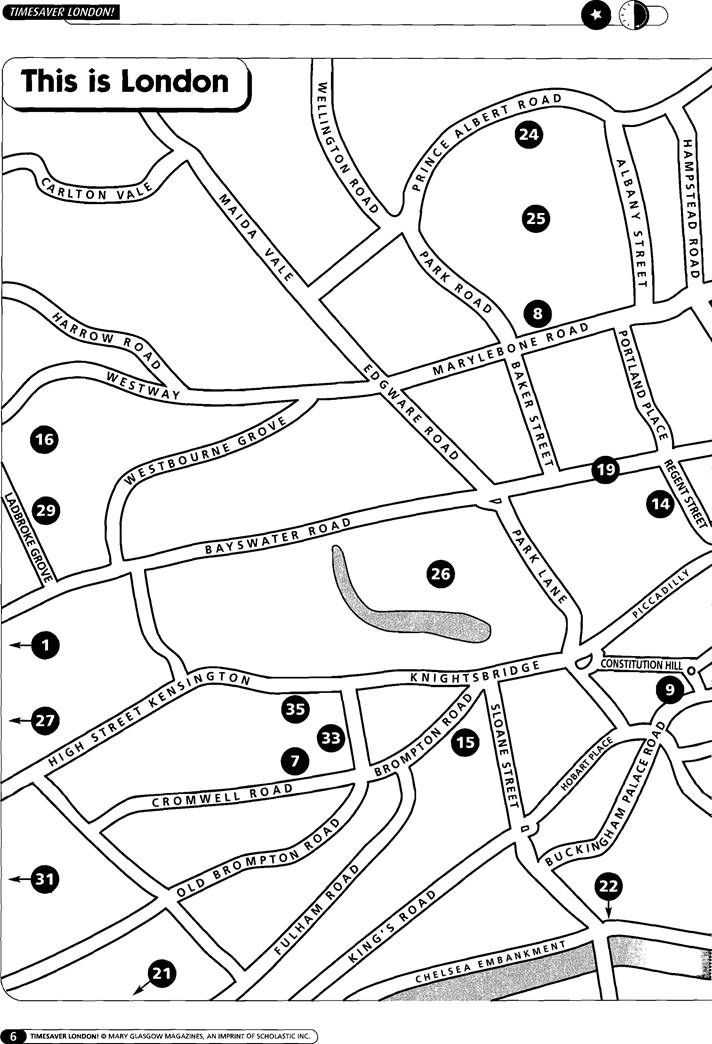 |
Q
0
0
0
0
0 0
Z
*XGH H O BO
0 ST R E ET
Z
…
一
0
、
V9
|
0 、 「 ~ 00 一 、 0 丶 0 |
pENTONVILLE ROAD |
0 |
|
|
R 0 A D |
K - N G S L A N D R 0 A D |
0
![]() 9000
罒'
9000
罒'
no、808 8
一 x
。
 0
0
0
0
0
BIRDCAGE WALK
-厃 冖丶 0
Q/
0
KENT
![]() ROAD ○
ROAD ○
Most people who come to London come by plane. There are five airports for London, but the most famous and popular are Heathrow and Gatwick.
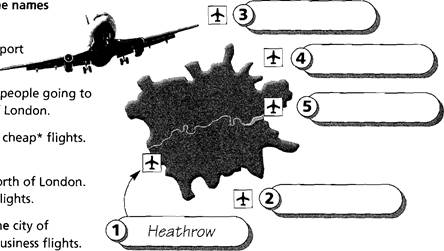
![]() Find the
five airports and write the names in the correct places.
Find the
five airports and write the names in the correct places.
Heathrow: This is the busiest* airport in the world. It's west of London.
Gatwick: This airport is for many people going to holiday destinations*. It's south of London.
Stansted: This airport is good for cheap* flights. It's north-east of London.
Luton: This airport is in a town north of London. It's also a good airport for cheap flights.
City: This is a small airport near the city of
London. It's for short flights and business flights.
![]()
 |
 A British
passport looks like this. Now fill in a passport for yourself.
A British
passport looks like this. Now fill in a passport for yourself.

![]() You are in the baggage hall.
You are in the baggage hall.
You arrive from Lisbon, Portugal. You have got a large rucksack and a large old suitcase.
Where's your luggage? é/é;Ð
Arrivals Time Baggage number reclaim
You want to leave the airport. Where do you go?
|
Entrance > |
|
Exit > |
|
Gates 1—10 > |
![]() D
D
To get to the centre of London from the airport is very easy. You can go by bus, train or taxi.
Many visitors go to the centre of London by train. Look at the leaflets and fill in the information. stansted express
Stansted Express is a fast way to and from Heathrow Express is a fast and convenient*
Stansted Airport, with trains every 15 or way to travel between Heathrow Airport and
30 minutes from Liverpool Street Station. London Paddington. It is a non-stop service and the it takes only 15 minutes.
And with a journey time of 45 minutes,
Stansted Express is a quick way to your With trains every 15 minutes, the Heathrow destination. A single ticket costs £13.00. Express is better than any other form of transport.
Why not book online NOW? For more information please click on Single tickets cost only £13.00.
'service news' or call 0845 8500 150
For information call:
(+44) 845 600 1515
Luton Airport is perfect for business and holiday
travellers. express
|
Thameslink takes you between London Bridge The Gatwick Express is a highstation and Luton Airport Parkway in 30 minutes. speed train between Central From the train station you catch the FREE bus, London and Gatwick Airport. With |
|
|
|
which takes you to the airport in five minutes. a journey time of just 30 minutes |
VOCABULARY |
|
|
Up to eight Thameslink trains an hour between from London Victoria Station to |
CHECK LIST |
|
|
London Bridge and Luton Airport Parkway |
Gatwick (35 minutes on Sundays), |
What is it in |
|
|
there is no faster way between |
your language? |
|
Fast trains take 30 minutes to London |
the city and the airport. |
Find out! |
|
£10.00 one way between London and |
Why not book online now? |
busiest (from busy) |
|
Luton Airport Parkway |
Single tickets cost £11.00. |
destinations |
|
Name of Where do |
How long How much |
cheap |
|
airport you arrive? |
does it take? does it cost? |
|
|
Heathrow |
|
to get off |
|
Gatwick Stansted |
|
signs (a sign) |
convenient
Luton

Seven million people live in London. How do they travel?

Help the tourist!
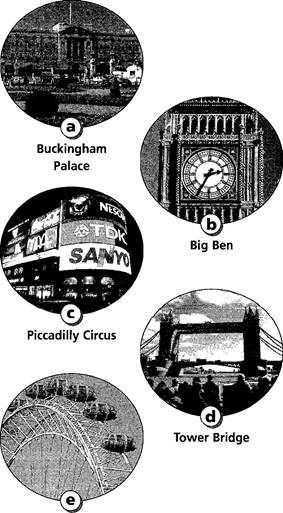
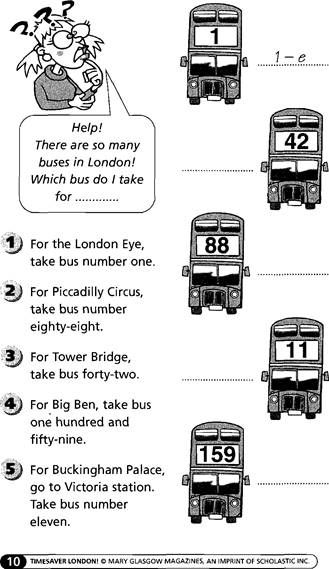 The
London Eye
The
London Eye
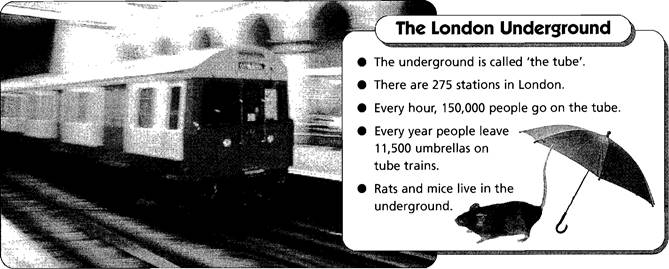
Most Londoners don't buy single or return tickets. They have got travelcards.
Put the correct information in the weekly travel card.
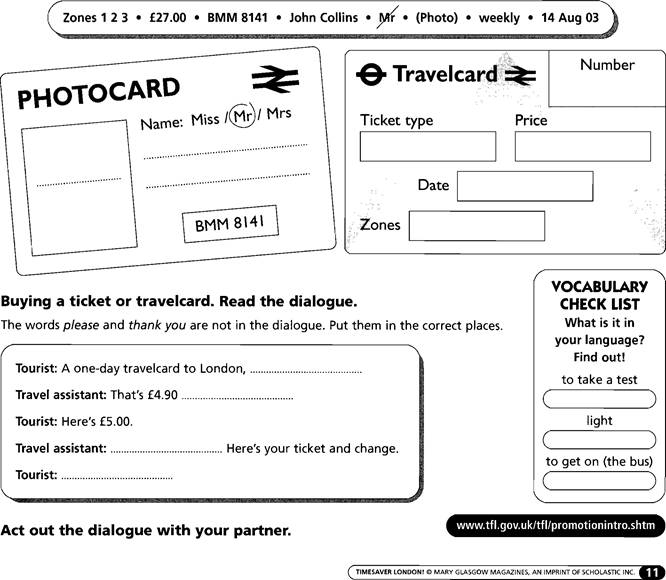
Read the instructions and colour the Tube map. Start at the spot (0).
Choose alternate* letters in the circles to find the name of each line*.
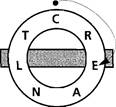 1) RED
1) RED
This line* runs through the centre of London and it joins Holland Park to Liverpool Street. Liverpool Street is also a railway station. This line goes under Oxford Street and the stations on Oxford Street are Marble Arch,
Bond Street, Oxford Circus and Tottenham Court Road.
It's the .. Central
This line goes through Notting
Hill Gate, Edgware Road, Barbican,
Tower Hill, Embankment, Victoria,
South Kensington, and back to
Notting Hill Gate again. Tower Hill is the Tube stop* for the Tower of London. South Kensington is the Tube stop for the Science Museum and the Natural History Museum. Westminster is the Tube stop for the Houses of Parliament and Big Ben, and Notting Hill is the stop for Portobello Market.
It's the ..![]()
![]() Z) DARK BLUE
Z) DARK BLUE
This line goes from King's Cross
(a railway station) through Covent
Garden, Piccadilly Circus, Leicester
Square, Knightsbridge and Earl's Court. Knightsbridge is the Tube stop for Harrods. Piccadilly Circus and Leicester Square are in the West End. This is the name for the area* with theatres, cinemas, restaurants and shops.
Heathrow Airport is at the end of this Tube line.
It's the . .![]()
This line also goes through King's
Cathedral) by boat. It's called Tate to Tate.

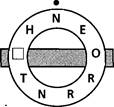 E) BLACK
E) BLACK
This line goes from Euston (a railway station) to Tottenham
Court Road, Charing Cross (another railway station) and then to Waterloo. Tottenham Court Road is the stop for the British Museum. You can go by
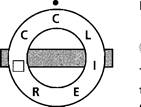 Eurostar train in
Waterloo Station to France and Belgium. Another part* of this line goes from
King's Cross, through Bank and on to London Bridge.
Eurostar train in
Waterloo Station to France and Belgium. Another part* of this line goes from
King's Cross, through Bank and on to London Bridge.
It's the .![]()
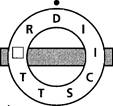 S) GREEN
S) GREENThis line goes from Tower Hill through St James's Park to Earl's Court. After Earl's Court, one part goes to Wimbledon in the south
(not on the map), and one part goes to
Richmond (not on the map). From Earl's Court it goes up to Paddington (a railway station) and ends at Edgware Road. St James's Park is the Tube stop for Buckingham Palace.
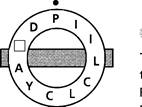 It's the
It's the![]()
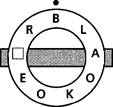 Z) BROWN
Z) BROWNThis line goes from Paddington, through Baker Street and
Regent's Park and on to Waterloo.
Baker Street is the Tube stop for
Madame Tussauds Museum and
Regent's Park is the Tube Station for London Zoo.
Its name comes from two of the stations on the line.
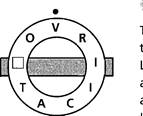 It's the . . . . . . . . . . . . . . .
. . . . . . . . . . . . . . . . . . . . . . . . . . . . . . . . . . . . . . . .
. . . . . . . . . .
It's the . . . . . . . . . . . . . . .
. . . . . . . . . . . . . . . . . . . . . . . . . . . . . . . . . . . . . . . .
. . . . . . . . . .![]()
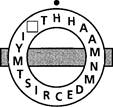 y PINK
y PINK
This line goes from Paddington to Baker Street, Barbican and Liverpool Street. The Barbican is an area of London with a large theatre and concert hall. The Museum of
London is in the Barbican.
It's the![]()
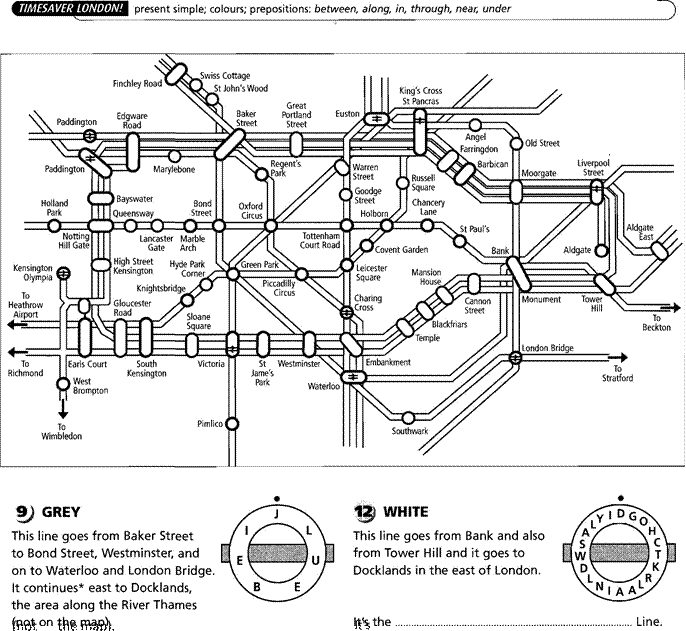
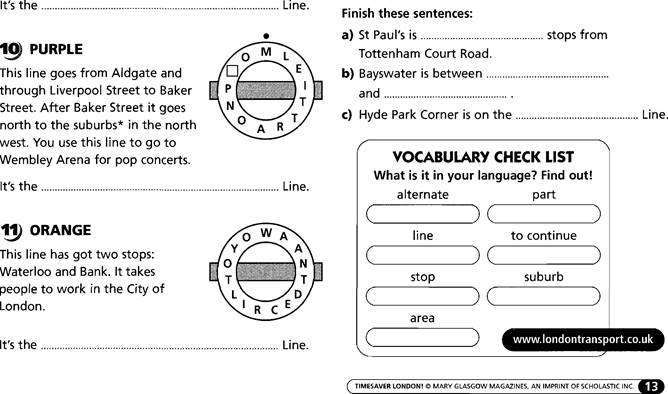
![]()
If you want to see London, the best place to go is the Eye. The Eye is a big wheel* on the River Thames.
The Eye is very popular. Every day 1600 people go on the Eye. There are 33 capsules* and one ride takes 30 minutes.
The Eye is very tall - 133 metres. At the top of the Eye you get a great view* of London. You can see for 25 miles (40 kilometres) but don't go if you are afraid of* heights* !
A great view!
|
|
Trafalgar |
Ben |
|
2 |
Tower |
Square |
TAXI
Imagine you are 133 metres high in your town / city. What places can you see?
![]()
How much does it cost?
You want to visit the London Eye. Here is the London Eye price list.

Look at these five different groups of people.
How much does it cost them to go on the Eye?
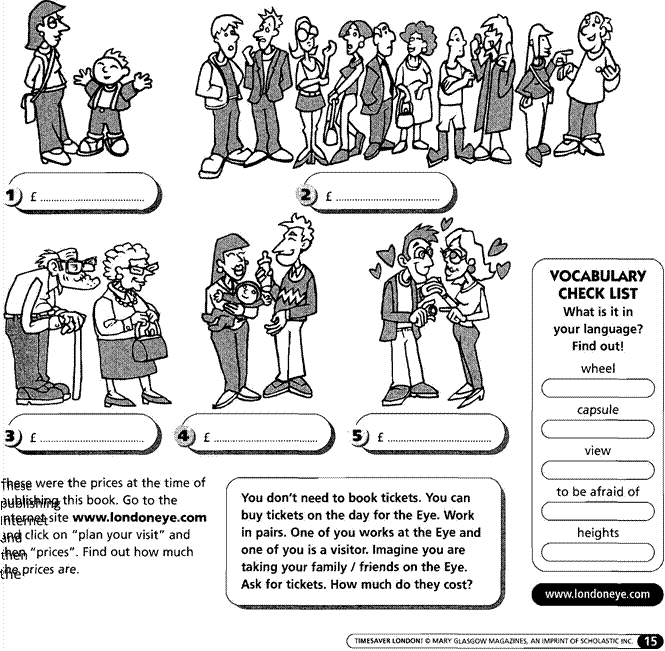
has got
The Tower of London is London's oldest castle*. It's nine hundred years old. It's got Beefeaters, ravens, the crown jewels and ghosts...!
Beefeaters don't eat beef!
They protect* the Tower. The name 'Beefeater' comes from when the Queen gave them meat, not money, as their pay. Beefeaters like the name Yeoman Warders. Forty Beefeaters (or Yeoman
Warders) live at the Tower.
I want to live at the Tower.
I don't want to live at the Tower.
The Crown Jewels are in the Jewel Room. The royal crown has got three hundred jewels on it, but the Queen only wears the crown once* every year!
I've got
Ravens*
They are scary birds. There are seven ravens here. If they leave the Tower it is very bad luck. Every day the ravens eat meat, eggs and biscuits with blood*. Yuk!
I like the ravens.
I don't like the ravens.
The Tower has got many ghosts. There are ghosts in the Salt Tower. Dogs don't like to go in the Salt Tower and Beefeaters don't like to go in there at night. Are you afraid of ghosts?
Yes
Find these numbers in the text.
c 900
has got
You are a prisoner*. You want to escape from the Tower.
Read the sentences and go to the correct key in the Tower. Draw your route on the map.
Take key number ten.
Go to key number fifteen. Run! There are Beefeaters here!
Go in the room. You see the crown. Take key eighty-eight and the crown.
Go to key thirty. Open the door.
Oh no! Ghosts! Run to key seventy-two.
 You see a Beefeater. He is
sleeping. Take key ninety-nine. Open the door and run!
You see a Beefeater. He is
sleeping. Take key ninety-nine. Open the door and run!
What is it in your language? Find out!
|
castle |
blood |
|
to protect |
once |
|
ravens |
prisoner |
,
London is the home of England's most famous and important river: the Thames.
Many important places in London are next to the Thames. You can find the Houses of Parliament, the Tower of London and the London Eye on the riverside.
The Thames is a short river. It's only 349 km long.
What's the name of the river The Amazon, in Brazil is 6,437 km long!
in your capital city?
Many people think the Thames is not clean but this is not true. More than 97 types of fish live here, for example salmon* and eels*. Eels are a How long is it?
traditional food in East London. People make a pie and serve it with mashed potatoes*. It's called It's . . . . . . . . . . . . . . . . . . . . . . . . . . . . . . . . . . . I 'eel pie and mash'.
Frogtours!
How do you go sightseeing without all the traffic? You can take a Frogtour. A frogboat is a tank for tourists. It travels on the road and on the river...but be careful - you get wet* on this tour!
You are on a frogboat in the Thames. Listen to your captain, draw the route and write the letters of the places you see in the correct boxes.
Before we go under Westminster
Bridge, you can see the Houses of
Parliament. You can hear Big
Do you like fish? Opposite The
Houses of Parliament is the London Aquarium.
Next to the Aquarium is The London Eye. You get the best view of London here!
We're going under two bridges. You can see a large ship in front of us. This is HMS Belfast, it's a museum ship.
|
|
ìiiiiii |
2 |
"Welcome to the one and only Frogtour. The best way to see the sights of London!" |
6 |
i i |
e |
8 9 The Tower of London St Paul's Cathedral HMS Belfast
|
|||||||||||
|
|
|
|
||||||||||||||||
|
The Houses of Parliament |
||||||||||||||||||
|
|
3 Westminstet Bridge |
|
||||||||||||||||
|
|
|
|
|
|||||||||||||||
|
|
||||||||||||||||||
|
||||||||||||||||||
Opposite HMS Belfast is the home of the Crown Jewels and the Beefeaters. This is the Tower of London. Now we're stopping here in front of London's most beautiful bridge, Tower Bridge.
VOCABULARY CHECK LIST What is it in your language? Find out!
salmon eel mashed potato dolphin to get wet

![]()
What is London's favourite sport? Football of course!
There are twenty-three football teams* in London. The biggest and most popular are Chelsea, Arsenal, Tottenham Hotspur, West Ham and Charlton.
Here are the most important football teams in London.
Tottenham Hotspur
Arsenal West Ham
Club: Chelsea
Colours: Blue
Chelsea Nickname: The Blues Stadium: Stamford Bridge www.chelseafc.com
Charlton
Chelsea star player: Hernan Crespo
Date of birth: 5th July 1975
Height: 1.85 metres
Weight: 78 kilograms
Club: Arsenal
Colours: Red and white
Nickname*: The Gunners / The Gooners
Club: West Ham Stadium: Highbury
www.arsenal.com
Colours: Claret (a kind of purple) and blue
West Ham star ex-player: David James
Date of birth: 1st August 1970
Height: 1.96 metres
Weight: 91.25 kilograms
Colours: White and blue Nickname: Spurs Stadium: White Hart Lane www.spurs.co.uk
Spurs star player: Robbie Keane
Date of birth: 8th July 1980
Height: 1.75 metres
Weight: 63.56 kilograms
Arsenal star player: Robert Pires Date of birth: 29 October 1973
Height: 1.88 metres
Weight: 74 kilograms
Which player
1 ...is the tallest?
2 ...is the oldest?
3 ...is the heaviest* ?
4 .has got the longest hair?
TIMESAVER LONDON! superlatives; chants
Most football clubs have mascots*.
Here are four mascots from the London clubs. Can you match them to their clubs?
a) West Ham c) Tottenham Hotspur
b) Arsenal d) Chelsea
3 Chirpy Cockrell Herbie Hammer
Here are two West Ham fans and two Arsenal fans.
What do you think they are saying?
Here are three chants. Which clubs do you hear them at?
Carefree
Wherever you may be
We are the famous CFC
2 Come on you Spurs!

VOCABULARY CHECK LIST What is it in your language? Find out!
team nickname heaviest mascot chant
looks like; possessives
There are more than one hundred museums in London.
The most popular museum is Madame Tussauds, the waxwork* museum.
It has so many visitors that you can wait for up to an hour in the queue*.
At Madame Tussauds you can meet hundreds of famous people jn one day. It's got wax models of pop stars, sports stars, film stars and politicians. It's even got a Chamber of Horrors, with famous criminals* . .. Don't go there if you
are afraid* !
Look at these four wax models. Which famous people are they?
He's American.
3
She's Australian.
She's a pop singer.
4 She's a Latino.
She's a singer and an actress.
He's English.
He's a football player.
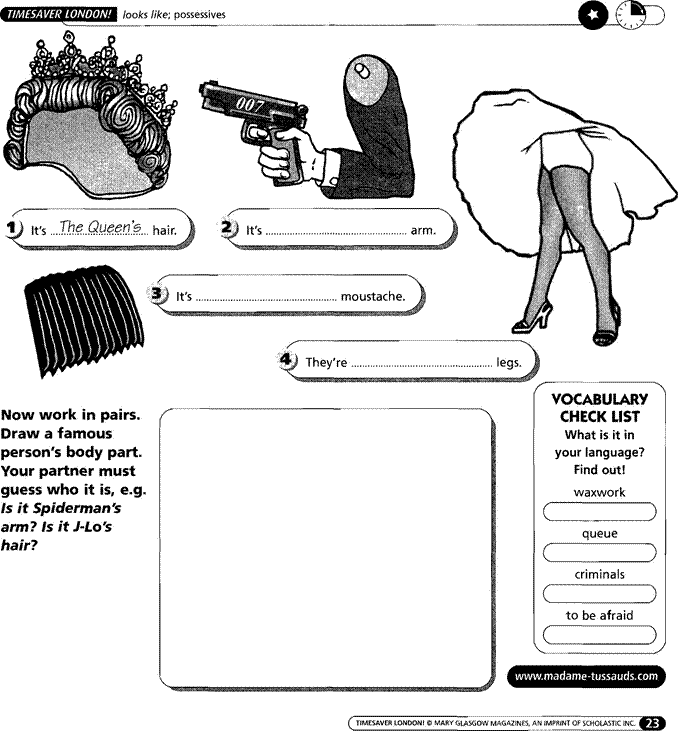 |

You are in the
wax work modelling room. You find lots of body parts. Which famous person's
waxwork do they belong to?
Would you like to live in a house with 600 rooms,
78 bathrooms, a cinema, a swimming pool and a post office?
If you are in London between August and October,
you can go inside Buckingham Palace. You can see the State dining room, ballroom, the Queen's gallery with all her paintings* and the mews where the royal coaches* and horses are. But you can't see all of the rooms. The palace is too big!
Look at the picture of the Palace. Read the description to find out which room it is.
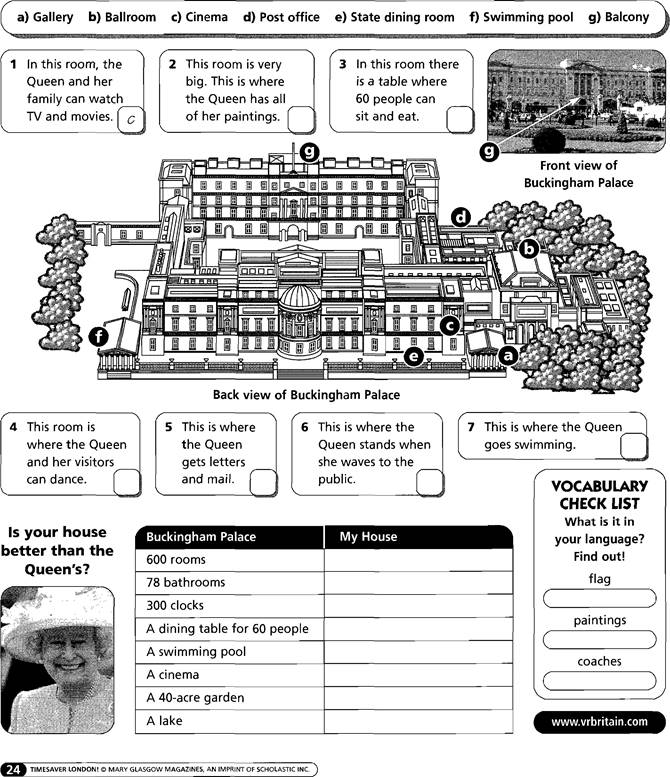
colours; modal can
![]()
The Butterfly House is in the garden of Syon House on the River Thames in west London. You can see tropical* butterflies from all over the world (Costa Rica, Argentina, Tanzania, Thailand, Indonesia, Australia and the Philippines).
The butterflies are in a big glass* house and they can comes out of the chrysalis after two or three weeks, fly everywhere*. Visitors can walk among them as its wings are wet and it can't fly because it must wait they feed* and fly. Some of the butterflies like to sit until blood* gets into the wings. Female butterflies on your head or shoulders! You can see the big are bigger than males. It's hot and damp* in the cages* where the caterpillars live. Caterpillars have Butterfly House because the temperature is always strong mouths, six legs, but no eyes. Caterpillars love 280 and the butterflies can't live in dry air or in eating and eat a lot of leaves. You can see other winds. They need damp air. There are lizards, cages with chrysalises* in them where the caterpillars iguanas, scorpions and spiders there, too. You can 'sleep' and become butterflies. When a new butterfly also the world's biggest snail* - it's 25cm long!
![]()
Find the Butterflies
Follow the colour key and colour the butterflies. Then, read the descriptions of each of the butterflies and write the names under the pictures.
|
VOCABULARY CHECK LIST What is it in your language? Find out! tropical to feed
cage
chrysalis
blood
damp
|

![]() 1 brown blue
3 white red 5 = yellow grey
1 brown blue
3 white red 5 = yellow grey
7 = black green orange 10 = pink
3 1 3
4 5 1 1 2
1 3 3
5
3 3 5 4 5
3 - 3
4 4
3 3
4 4 Z) 3)
a) The BANDED SOLDIER is red with black Near the body, the wings are blue and stripes*. there are small pink stripes on the
b) The ROSE BUTTERFLY is brown with four back wings.
red spots* , three white spots and a yellow e) The RODRIGUEZ AGRIAS BUTTERFLY spot on its two back wings. has got grey and blue back wings and
c) The ACHILLES BUTrERFLY is brown with a grey, blue and red front wings. large blue stripe and small white spots on f) The MONARCH BUTTERFLY is yellow its wings. with red, grey and yellow spots on the
d) ![]() The SAPPHIRE
BUTTERFLY has got green, orange, black and yellow strips on its wings.
The SAPPHIRE
BUTTERFLY has got green, orange, black and yellow strips on its wings.
![]()

Which floor?
Hamleys has got seven floors* of toys. Look at the floor guide*.
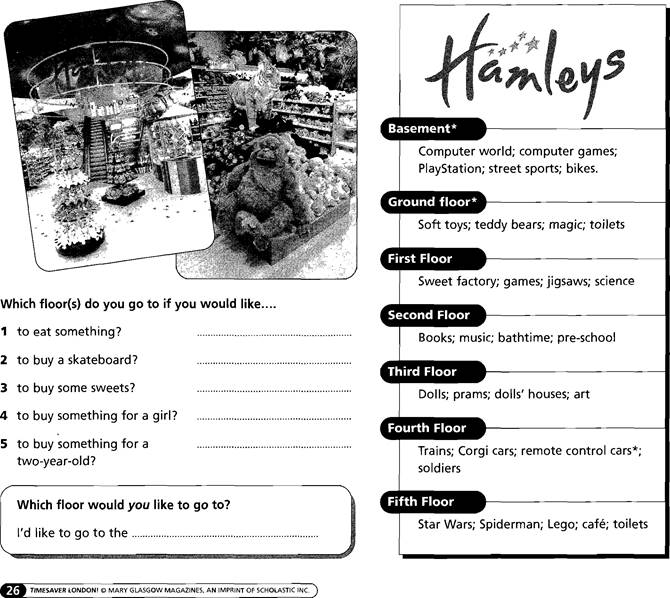
ordinal numbers; Where is? / Where are?
In the shop: work in pairs
One of you is the shop assistant, one of you is the customer.
Customer: Look at the pictures 1-6. Ask where these toys are.
e.g. Excuse me, where are the computer games?
Assistant: Look at your floor guide and reply
e.g. They are on the first / second / third, etc, floor.
o
Every year there is a new toy craze*.
Design a toy that every child will want and describe it.
VOCABULARY CHECK LIST
What is it in your language? Find out! floor
basement
ground floor
remote control car
craze
![]()
![]()
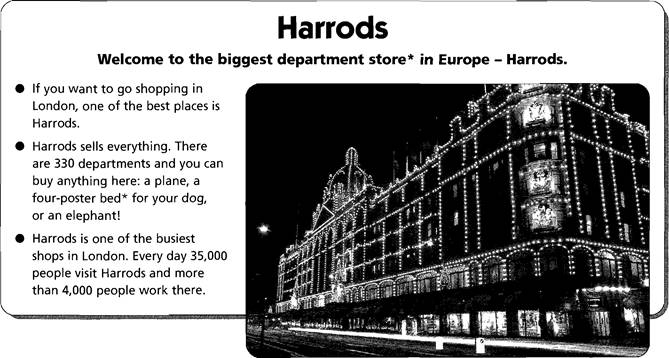
Look at these 6 signs and circle the correct word.
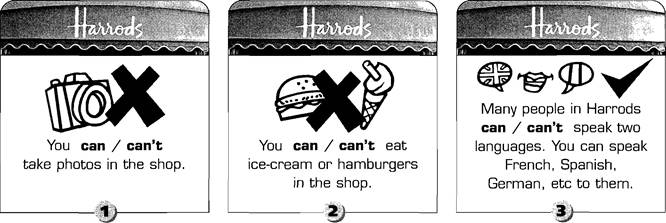

modal can; asking for a refund
Problems, problems!
If you buy something in Harrods and there is a problem with it, you can take it back. Harrods can give you the money (a refund* ) or something of the same price (an exchange*). But you must have the receipt.
![]()
Take it back!
Put these phrases in the correct speech bubbles.
It's too big.
OK. What's the problem with it?
That's
fine. Have you got the receipt? ![]()
Yes, it's this jumper. Yes, here it is.
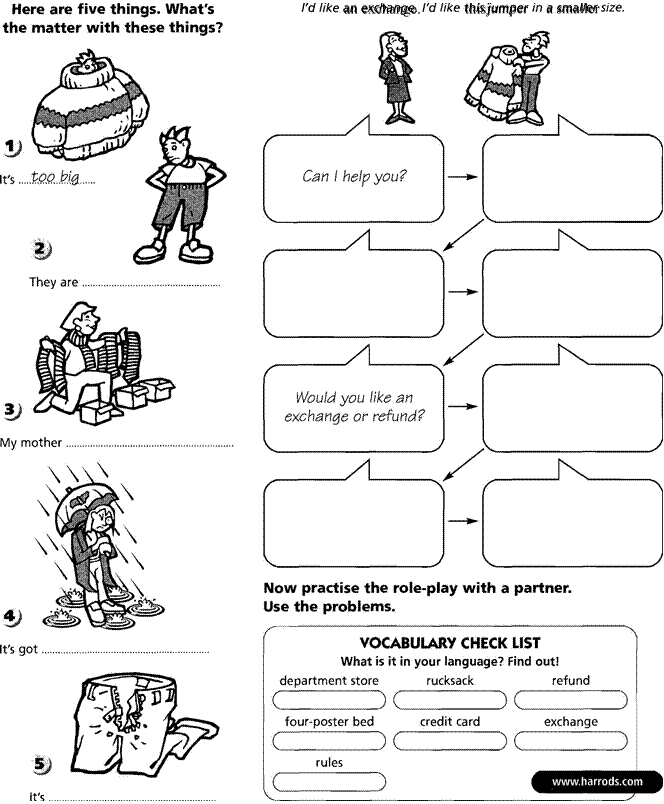
O
London has got more than 65 street markets where you can buy everything and anything. The two most popular markets in London are
Covent Garden market and Camden market.
Covent Garden was* the biggest fruit and vegetable market in England but now it's got more than bananas. Now it's got hundreds of shops, stalls* restaurants and bars. You can buy almost anything here!
If you don't like shopping, you can watch the coolest* street artists in Covent Garden. The best street artists in the world come here. You can see jugglers* , dancers, mime* artists and people on stilts* and unicycles*. Watch out for the fire-eaters!
![]()
Camden market is the fourth most popular tourist attraction in London. Camden
is like four different markets in one place. Camden is famous for its cool
street fashions, vegetarian food, music stalls and jewellery. There are more
tattoo* and piercing* shops here than in any other part of London. And if you
don't want to shop, buy music or get a tattoo, it's a great place for
people-watching!
Can you... ?
juggle with two oranges?
juggle with three oranges?
stand still without moving?
ride a unicycle? play two musical instruments at the same time?
|
|
Here are five other famous London markets. Match the markets to their photos the next page. |
on
Billingsgate market
|
|
(5.00 am - 8.00 am) Do you like fish? Billingsgate is not a market for tourists. This market sells fish. It's the smelliest* market in London! |
Columbia Road market
|
|
Roses, carnations, they are all here. best market to go love flowers. It smells beautiful! |
daises... This is the to if you
Portobello Road
|
|
(7.00 am - 6.00 pm) Do you like collecting* things? You can buy stamps, coins, medals antiques here. |
old and
Brixton market
|
|
Brixton market is in south London. You can buy lots of Jamaican food but you can buy clothes here too. |
S Petticoat Lane market
|
|
(Sundays) This is the oldest market London. It's over 400 years old. It is famous for its clothes and lace* and is in East London. |
in
superlatives; How much is / are; Can you... ?
a c
d Which market would you like to go to?
I'd like to go to
You are at Camden Market in London.
Look at the questions and tick (V) the correct word (is or are). The correct answers move you to the correct stall.
|
How much the CD? |
How much the strawberries? |
|
move 1 . 10.00 |
is move 2 |
|
move 1 |
move I |
|
How much the jacket? |
How much the old clock? |
|
move 1 |
move 4 f . |
|
move 2 |
move 1 |
|
How much the hot dogs? |
How much the boots? |
|
move 4 |
move 4 |
|
f . |
f . |
|
move 3 |
move I |
Now write the correct prices in the boxes.
COOL
What is it in your language?
Find out!
was
stall
cool (coolest)
juggler (to juggle)
to mime
stilts
unicycle
tattoo
piercing
smelliest (smelly)
to collect
SHOES
Start

![]()
If you come to London you must spend one night at the theatre!
In London there are 51 theatres and every year 1 1 million people come to watch a play or a show. You can see everything here — opera, comedy, drama, dance and musicals.
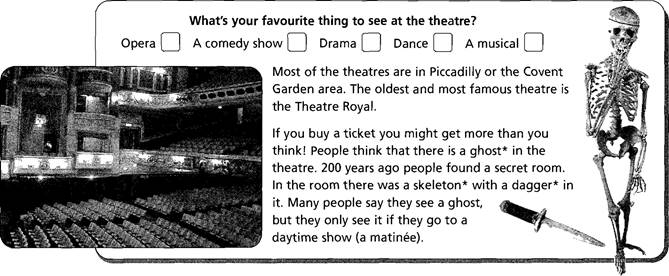
The most popular shows in London are musicals. Here are London's top musicals. Look at the titles of the musicals and match them to their stories.
a) This is the story of an ugly old composer* who lives under an opera house in Paris. He is in love with a beautiful opera singer.
|
|
|
|
b) This is the story of a group of students who |
|
|
The Phantom |
|
want to sing, dance and be famous. They go |
|
|
of the Opera |
I H E MUSIt41 |
to the New York School of Performing Arts. |
|
|
2 |
|
c) This is the story of an inventor and his family. They have many adventures in their car that can fly. d) This story is in Africa. It's about Simba the lion. e) This story is about a simple London girl who sells flowers. She meets Henry Higgins who wants to teach her how to become a 'lady'. |
|
4 |
|
|
f) This was a film. It's about two teenagers, Sandy and Danny who fall in love* on holiday. When they meet again at school, love is not |
|
|
CATTY |
|
so easy! g) This musical was a film with Catherine ZetaJones and Renée Zellweger. It's the story of two dancers, Roxie and Velma in America in |
|
6 |
|
|
the 1920s. |
Which musical would you like to see? I'd like to see
![]()
1 st conditional; booking a ticket
|
At the |
|
Booking a ticket |
||
|
box office |
|
Here are some things you say and hear when you are booking tickets for a show. |
||
|
Musicals are very popular. It's not easy to get a ticket. For the most popular shows |
|
Choose the option that is grammatically correct. |
||
|
you can wait for six months |
|
a) Hello. Theatre Royal box |
|
a) We like two tickets in |
|
to a year to see a show! There are three different |
|
office, can I help you? |
|
the stalls, please. |
|
types of ticket: |
|
b) Hello. Theatre Royal box |
|
b) We'd like two tickets in |
|
Stalls These are the expensive |
|
office, can't I help you? |
|
the stalls, please. |
|
seats. They are on the |
|
a) Hello. I can to book |
9 |
a) What time does the |
|
ground floor in front of |
|
|
|
|
|
the stage. Circle |
|
ticket for The Lion King, please? |
|
show start? b) What time starts |
|
These are above the stalls. The front rows are expensive but the other rows are cheaper than the stalls. Balcony These seats are the cheapest seats. They have a very good view but the seats are high. If you are afraid of heights, or have bad eyesight don't go! |
|
b) Hello. Can I book tickets for The Lion King, please? a) I'd like tickets for January. b) I like tickets for the January. |
|
the show? a) Can I pay by credit card? b) Can I paying by credit card? |
|
They will also ask you: "Matinée or evening?" |
4) |
a) Are you like stalls, circle or balcony? b) Would you like stalls, circle, or balcony? |
|
|
THE LloÑ
Now make your own dialogue to book a ticket for a musical. Use the sentences above to help you.

©
![]()
Battersea Dogs' Home is a famous home for lost* or abandoned* dogs and cats in London. It's nearly 150 years old.
|
|
|
Battersea Dogs Home |
Every day 27 dogs come to the Home. That's about 10,000 every year!
The Home gives dogs and cats a place to sleep, medicine, food and love. It tries to find good homes for the dogs.
Here are three of the dogs in the Home at the moment. Match the description to the dog.
|
I'm Rosie Baby. I'm two years |
I'm Bob. I'm eighteen months |
I'm Nova. I'm very intelligent. |
|
old. I'm small and white with |
old. I'm small and black with |
I'm big. I'm brown and black. |
|
brown ears. I like toys, games |
a white stomach. i like |
I like walks. |
|
and walks. |
biscuits and treats* I don't like cats. |
|
|
Pet Quiz! |
|
|
|
|
|
|
What's the most popular pet in Britain? |
a) rabbit |
b) dog |
c) cat |
||
|
What's the most popular pet in the world? |
a) canary |
b) dog |
c) hamster |
||
|
How many people own dogs in Britain? |
a) 10 million |
b) 6 million |
c) 8 million |
||
|
Which pet lives the longest? |
a) goldfish |
|
c) canary |
||
|
What's the most popular breed of dog in Britain? |
a) poodle |
b) Alsatian |
c) Labrador |
||
|
In which country was the first dog show held in 1859? |
a) France |
D b) Britain |
c) America |
||
![]() 4
4
6
![]()
Where's Sam?
Your dog is missing*. You telephone Battersea Dogs' Home.
|
Assistant: Hello. Battersea Dogs' Home. You: Oh hello. Our dog's missing. We want to check if it's in the Home. Assistant: Oh dear. When did you lose your dog? You: Two days ago. On Wednesday. Assistant: Has it got microchip identity? Or a collar* ? You: No. He's called Sam. |
Assistant: OK. Describe him to me. You: He's four years
old. He's small and black with a white ear and a white tail. Assistant: OK. We'll have a look. Which ear is white? You: The left ear. Assistant: OK. Can you call me back in an hour? You: Of course. Thank you. |
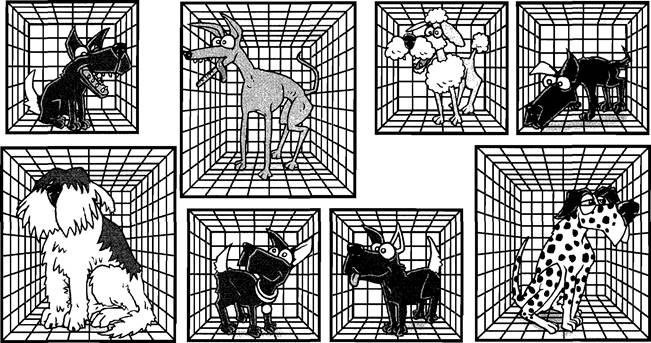
Work in pairs. One of you works at the Dogs' Home; one of you can't find your dog.
You are never far* from a restaurant in London.
London has got more than 10,000 restaurants, so you can't get hungry!
Here are some of the foods you can find in London.
Look at these seven dishes. What are they?
pizza • cheeseburger • fish and chips sushi • curry • noodles
Z)
Which one is your favourite?
What is London's traditional dish? It's pie and mash (mashed potatoes). This is a traditional East End dish.
What's in the pie? Eels* ! There are lots of eels in the
River Thames. Not many Londoners eat eel pie and mash though!
Not everybody tikes pie and mash but everybody loves fish and chips! The oldest fish and chip shop in London is the Rock and Sole Plaice. It's more than 130 years old. Most English people love to eat fish and chips with salt and lots of vinegar*.
What do people eat with their chips in your country? salt ketchup mayonnaise vinegar
When you get your chips, the assistant sometimes says "Open or wrapped*?"
What do you think this means?
In England, Chinese food is the most popular takeaway*. The most popular dish is lemon chicken. In the centre of London there is an area called Chinatown. There are many Chinese restaurants and Chinese shops. In the windows you can see the chefs cooking the food.
There are more indian restaurants than fish and chip shops in London. If you want to eat an Indian curry, the best place is Brick Lane. Brick Lane is in Whitechapel, East London. The most popular dish is chicken tikka masala.
Here are 8 restaurants you can find in London. Look at the signs. What type of food do you think they sell?
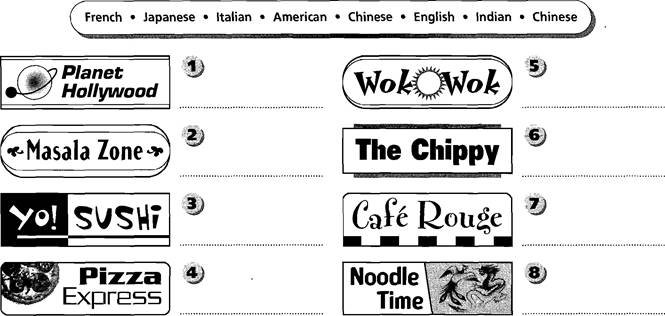
1 You are looking for a table. You see a table. It's got the sign "Reserved" on it.
Do you...
' sit at the table? > rice
• look for another table? > fish
3 You want to pay. What do you ask for?
' The bill > vinegar
• The ben > tomato sauce
Who says it?
You are in a restaurant. Who says these phrases, the waiter or the customer? Write W or C next to the correct phrases.
Ready to order?
I'm a vegetarian.
I'm allergic* to nuts.
Would you like some pepper?
Would you like anything to drink?
Choose a restaurant from the list above. Find a partner to be the waiter and make a dialogue together.
![]()
London is the biggest city in Europe and the 20th biggest city in the world.
Over the centuries, people from all over the world have come to London. They came to find freedom, to find work, to meet people and live an interesting life. They make London an exciting and diverse* city.
Today, more than seven million people live in London and 46% of these are under 35 years old.
Look at this pie chart. It shows the different ethnic groups that make London so cosmopolitan*. a-pa,
White British
140/0 White other
(e.g. Irish / European /
Get into groups to discuss these
Australian / American) questions:
9% Black African
What's the population of your
8% Black Caribbean
town I city?
70/0 Indian
3% Chinese
What are the difficulties for
3 0/0 Other people from different cultures I ethnic groups living in London?
Imagine you arrive to live in London to start a new life.
You go to the Internet café to write home. Complete the e-mail with your own ideas.
Dear .
How are you? I arrived in London on Tuesday.
I'm living in . (a flat / house / bedsit*)
in . (area in London)
The most difficult thing about living in London is ..
The best thing about living in London is
Hope you are all well. I will call you next week.
Love .
![]()

It's easy to find work in London, especially if you want a summer or a part-time job.
But telephoning for a job is not always so easy. Gianni is looking for a job, but he doesn't use the correct style of English.
Match what his wrong way of saying things to the right way of saying things.
![]() 3D Cool. So what's it
like then? What are the hours of work like? I hope I don't
3D Cool. So what's it
like then? What are the hours of work like? I hope I don't
|
have to work late. What's the pay like? |
|
I'm calling about the vacancy* in Monday's |
|
I have to know about the money! |
|
Evening Standard. Are you still looking for |
|
Yeah. I've done a bit of waiting before |
|
somebody? |
|
in Italy. In the summer, I think. I'm |
(9 |
Yes I have got some experience of waiting. |
|
Italian, so what more could you want? |
|
Last summer I worked in a small restaurant |
|
E) Sure. I'll drop in on Tuesday at three. |
|
in my home town of Pisa, so I know how to |
 See wait
and I know Italian food!
See wait
and I know Italian food!
comparatives, superlatives; ago; have to, must
The Boat Race
Every country has got its own strange historic sport or race such as the Palio in Sienna, Italy, or the Pamplona Bull Run in Spain, but the Boat Race in London is one of the most extraordinary to understand. It is simply a race between two boats, one from Oxford University and one from Cambridge University. 2004 is special because it's the year of the 150th Boat Race.
History
The first race was in 1829 in Henley, a small town on the Thames. 20,000 people watched it and now Henley is famous for its annual regatta - a series of boat races in July each year. People come dressed in fashionable clothes and have expensive, luxurious* picnics on the River during the races. After the first year, the Boat Race moved to Westminster, but by 1845 when
Westminster became too crowded*, the Race moved six miles (9.65 km) up the River Thames to Putney which was only a village in those days but it's a fashionable suburb of London now.
Facts
1,200 hours! That's a lot of training!
The Race takes place at Easter time, and the water in the River Thames between Putney and Mortlake is very tidal*. The streams of water move very fast when the tide is coming up the Thames. The weather, the tide, and the bends in the River mean that the difficult parts of the River are exposed* to winds from different directions and this adds mystery to the unpredictable* conditions.
The Spectators
400 million people in the world watch the Boat Race on TV, and 7.7 million people in Britain watch it. The Boat Race is in the top five live* TV sports events on British TV.
VOCABULARY CHECK LIST
What is it in your language? Find out! IUXUriOUS
crowded
approximately
to steer
crew
exposed
unpredictable
live (ad)
www.theboatrace.org
Like all famous sports, there are lots of statistics connected with it.
Fill in the missing words in these sentences and then find them in the word search grid.
Draw red lines through them all when you find them. The extra words in the grid
(not coloured red) spell the name of the oldest person to take part in the Boat Race, and they also tell you what happened in 1912.
|
|
|
|
|
|
|
|
|
|
||||
|
|
|
|
|
|
|
|
|
|
|
|
||
|
E |
|
A N S |
|
|
D S S |
|
|
I S |
||||
|
|
|
|
|
E |
|
R E G E |
|
|
||||
|
A |
|
O B L |
|
|
E R G |
|
H I |
|
||||
|
|
|
|
|
|
|
|
|
|
||||
|
E |
|
A S A |
|
A N U |
|
|
E A |
|||||
|
|
|
|
|
|
|
|
|
|
||||
|
|
|
|
|
|
|
|
|
|
||||
![]() The
The ![]() fastest time for the
Boat Race is 16 minutes, 19 seconds. Cambridge did this in 1998.
fastest time for the
Boat Race is 16 minutes, 19 seconds. Cambridge did this in 1998.
Christopher Hibbert was the ![]() oarsman to row in the
Boat Race. He weighed 110.22 kg.
oarsman to row in the
Boat Race. He weighed 110.22 kg.
![]()
![]() Matthew Brittin
(Cambridge) was the
Matthew Brittin
(Cambridge) was the ![]() person to take part in the Boat Race. He
was just eighteen years old in 1987.
person to take part in the Boat Race. He
was just eighteen years old in 1987.
The ![]() winning
margin (the distance between the two boats at the finish) was just 0.3048m.
This was in 2003. It was a very exciting race!
winning
margin (the distance between the two boats at the finish) was just 0.3048m.
This was in 2003. It was a very exciting race!
The ![]() . oarsman rowed for Cambridge. He took
part four times in the Boat Race: in 1999, 2000, 2001 and 2002. He measured 2m
7cm.
. oarsman rowed for Cambridge. He took
part four times in the Boat Race: in 1999, 2000, 2001 and 2002. He measured 2m
7cm.
70 In 1981, Sue Brown (Oxford) was the first .![]() to
take part jn the Boat Race.
to
take part jn the Boat Race.
![]() Y The
Y The ![]() twins rowed in the
Boat Race in 1982.
twins rowed in the
Boat Race in 1982.
90 In 1989, both Oxford and Cambridge had .![]() coxes.
coxes.
When people hear the word Wimbledon they think of one thing - tennis.
Wimbledon in south-west London is a pretty, quiet place. But for two weeks in the summer it's really busy. Wimbledon is the home of one of the most important tennis championships* in the world.
In the last week of June and the first week of July, more than half a million people come to Wimbledon to see the world's best tennis players.
After two weeks, with more than one hundred matches and 15,000 tennis balls, you have two tennis champions!
Wimbledon is more than just tennis. Here are five things you can see at Wimbledon!
If you visit Wimbledon you must have strawberries and cream. They are expensive but it is the tradition!
S Umbrellas
|
It may be the summer but it is |
|
The traditional summer drink |
|
traditional for it to rain at some |
|
is Pimms (an alcoholic drink) |
|
time during Wimbledon so you must take an umbrella! |
1 biedori Clothes |
and lemonade. |
|
4 Tents |
The tennis players have |
|
a dress code* (they Yes, at Wimbledon it's possible to buy tickets on must wear white).
the same day, but there are not many and the first people in the queue* get the tickets. That's why some people camp the night before so they are the first in the queue!
![]()
Wimbledon rules Tennis talk!
You are playing at Wimbledon. You are serving*. Are you a tennis expert?
Read the sentences below and chose the correct answer. You hear people
Find that answer in the tennis balls and see talking in the crowd. how many serves you get. What do they mean?
1 Players must / mustn't wear white.
|
ACE |
|
|
2 You must / mustn't take photos during a match. opponent
3 You mustn't / must buy a ticket before the match.
"Wow! Roddick 4 You must / mustn't talk during a match.
hits another ace!"
5 Lots of people drink Pimms at Wimbledon. But you must / mustn't drink it if you are under 18.
a) Roddick serves. The other player can't touch the ball. Roddick scores a
b) Roddick hits the tennis ball into the net.
|
2 |
LOVE |
|
|
|
stn't
stn't
"Oh no! Tim is losing two games to love. '
a) Tim is in love and can't play very well.
b) Tim has no points.
tan
|
SEED |
xaffi
"That player is one of the seeds. '
a) The player is one of the best in the world.
b) The player is one of the worst in the world.
as-a-a0
VOCABULARY CHECK LIST
What is it in your language? Find out!
|
championship |
queue |
|
dress code |
to serve |

TIMESAVER LONDON! must; 1st conditional; some, any, no, lots, a few
If you love adventure, you must visit some of the theme parks near London.
If you want to go to Chessington, you must get a Kumba and Kaya (the mum and dad)/ their daughter train from Waterloo Station. Chessington is south Asili, and Asili's daughter, Shani. There is also a big sea west of London in a county called Surrey. There are lion called Boris. He weighs 1,764kg! He's too heavy lots of scary* rides*. They measure you for some of for all the rides but he can hear all the screams* !
the rides. Small children mustn't go on any of the If you love Harry Potter, wizards* and magic, there's a dangerous rides (The Vampire, The Samurai, Dragon scary house called Hocus Pocus Hall. If you don't like Falls, the Black Bucaneer and the Seastorm). Also, scary things, you can go on the Skyway Safari. This is very fat people can't go on some of the rides because a slow and gentle monorail and you can look down it's difficult to close the safety bars* on the seats if on the theme park from the sky. And if you like lots you are too big. of action, you must go on the ride called Tomb One part of Chessington is called Animal Land. It Blaster. It's an interactive* ride — all the people on hasn't got any rides, but it's got a zoo with some the ride have laser guns and they can shoot all the wonderful animals. There is a gorilla family with baddies* they meet.
Thorpe Park is in the west of way Out 20m above the ground and each of London, near Heathrow Airport. If you are afraid* of the dark, the little cages rotate (go round) It's got lots of very scary rides. don't go on this ride! It's one of fifteen times.
Here are some of them: the first rollercoasters in the world The Tidal Wave
Nemesis Inferno where you go backwards* through This is one of Europe's highest This rollercoaster* goes upside the dark. There are no little water rides. It lasts down. It's a journey* through a children on this ride! 136 seconds. volcano and you travel at 77km/h. The Eclipse
Colossus Some people prefer*
This rollercoaster climbs to 30m a quiet ride and this then falls to the ground and goes is like the Safari up into the sky like a rocket. It Skyway in Chessington. goes into a 3600 loop*. It twists* You can look down on through the air over the water all the other rides.
and does 10 loops during the ride. The Vortex
1050 people go on this ride every This very fast ride is in a hour. Some brave people go on it part of the Park called The again and again! Lost City. This ride swings*
VOCABULARY CHECK LIST What is it in your language? Find out!
scary scream baddies loop backwards
ride wizard rollercoaster to twist to prefer
safety bar interactive journey afraid to swing
Both these parks are closed October-March.
![]()
If you go to Chessington World of Adventures, where can you find the Tomb Blaster ride?
Choose the letters next to the correct parts of the sentences and you can find the name of that part of the theme park.
![]() 2
2
are 3
|
4
5
There are 6 7 morning. 8 don't like scary rides but
there are 9 (lots — T / a few — B) of things for them to do. 10 visit is complete without a meal in one of the themed restaurants. 12 |
frightening!
Have you got 15 some — J) favourite rides from theme parks in your country? 16 In Beanoland at Chessington
there are 17 (a few - H / lots - F) of rides with names
of characters from the comic, The Beano, such as Dennis's Madhouse. Dennis
the Menace is a naughty boy in The Beano. He's got a dog called Gnasher. Do
18 19 |
9 16 5 17 11 4 13
![]() At many theme parks there are some
stars next to the names of the rides to warn you how scary they are. X:\No Way
Out has got five stars. Some other rides have four stars, some have three, some
have two and some have one star.
At many theme parks there are some
stars next to the names of the rides to warn you how scary they are. X:\No Way
Out has got five stars. Some other rides have four stars, some have three, some
have two and some have one star.
Here are the different meanings of the stars. Choose one, two, three, four or five stars for each of them.
|
|
Name: Pigeon Eats: Insects, nuts, bread, |
Footprint: |
|
|
|
chips |
Fact: |
|
|
|
How many? |
Pigeons can live for |
|
|
|
40,000 pigeons fly into |
35 years |
|
|
|
Trafalgar Square every |
Pigeons live in |
|
|
|
day |
my town / city |
o |
|
Name: Fox Eats: Small animals, insects; loves 'fast food' (eg |
Pawprint: |
|
|
|
hamburgers and chips) |
Fact: |
|
|
|
How many? |
Foxes have a white tip* |
|
|
|
There are 30,000 in |
on their tails |
|
|
|
London! A fox even |
Foxes live in |
|
|
|
lives in Downing Street! |
o my town / city Pests! |
|
|
|
Pigeons, foxes and rats are pests* that damage* buildings and spread disease*. |
|||
|
The Mayor of London wants to reduce* the number of pigeons and rats in London. |
|||
|
Name: Rat |
For example, it is now against the law to feed the pigeons in Trafalgar Square. |
||
|
Eats: |
Here are six ideas to reduce the number of pigeons, foxes and rats. |
||
|
Insects, fast food, rubbish |
What's your opinion? 1 = the best idea 6 = the worst idea |
||
|
How many? |
o Put more litter bins in the city o Encourage people to have cats |
||
|
There are 60 million |
o Put poison* in the streets to o Fine* people who drop litter |
||
|
in the UK |
kill the animals on the street |
||
|
Fact: |
o Put traps* in the streets to o Make fast food shops pay a |
||
|
There are more rats than people |
kill the animals 'pest tax' |
||
|
in London Pawprint: Rats live in |
Who are the real pests - people or animals? VOCABULARY CHECK LIST What is it in your language? Find out! to damage to reduce trap |
||
|
my town / city QD |
pest to spread disease poison to fine |
||
![]()
www.wildlondon.org.uk/wildinfoffoxes.htm
Fill in the missing words in the text to find a fascinating fact about sharks.
The words in boxes make the fact sentence.
|
fish CDU.S. |
like OBY eating KILLED sleep ARE |
facts THE weapon |
SHARKS |
|
shark IN |
strange BEES males THAN |
temperature |
PEOPLE |
The London Aquarium is opposite the
Houses of Parliament, on the bank of the River Thames. In the different areas of the Aquarium you can see fish from the different oceans of the world.
In the Pacific area you can see the sharks and sting rays. You can look at them from two . floors MORE of the
Aquarium because they need very deep water. The of the water must always be 23 0 . There are three sand tiger sharks, three brown sharks, a nurse shark called Florence and Mazawabee, a zebra .
. You can learn lots of
about sharks at the London Aquarium.
Sharks are the only
![]() with their eyes open. Great white sharks
love but they don't chew their food. They rip* their food into chunks* and
swallow them whole. Tiger sharks can be dangerous because
with their eyes open. Great white sharks
love but they don't chew their food. They rip* their food into chunks* and
swallow them whole. Tiger sharks can be dangerous because
people but the good news is they don't like the taste and they usually stop after
FACT: More
one bite. Sharks are heavier than water and they can easily sink if they stop swimming.
creatures. They can easily push their stomachs up through their mouths when they want to eat. Bleeaagghh!
On a coral reef* you can see lion fish, eels, bat fish,
pipe fish and sea horses. These unusual fish can swim upright, and the not the
females, give birth to the babies. The box fish can easily protect itself when
it's in danger. Its secret ..![]()
![]() is poison. It squirts* poison into the
water when danger approaches, but it has to swim away quickly because it can
poison itself, too!
is poison. It squirts* poison into the
water when danger approaches, but it has to swim away quickly because it can
poison itself, too!
The electric knife fish which lives in Venezuela has got tiny eyes and it can hardly* see. It uses electricity to hunt for food.
VOCABULARY CHECK LIST What is it in your language? Find out!
chunk
coral reef
to squirt
to puff
London Zoo is in Regent's Park near the centre of London.
It's open every day of the year except Christmas Day. There are 600 different species (kinds) of animals, birds, insects and reptiles there. It has changed a lot since it first opened in 1828, and although many people now think it's cruel to keep animals in zoos, it's a good place to protect* animals in danger and to educate people, especially children, about the natural world. Some of the animals became living legends in their lifetimes.
Guy got his name from the day when he was born
- Guy Fawkes Day (November 5th). He was born in 1947 and arrived at the zoo holding a little metal* hot water bottle. He was very gentle and everyone loved him. When sparrows* flew into his enclosure (the space where he lived), he picked them up* gently in his hand, looked at them closely, and then let them fly away. Signs everywhere told the visitors not to
feed the animals, but people gave Guy sweets and he got toothache. He died during an operation* to remove his tooth. There's a statue of Guy at London Zoo.
Belinda died in 1993 when she was 23 years old. She was a great advert* for London Zoo because she helped hundreds of people conquer* their spider phobia. The zoo allowed people to hold beautiful Belinda in their hands and usually this cured them.
Goldie escaped in 1965 and thousands of people went to Regent's Park to watch him flying from tree to tree. It caused big traffic jams* around the area near the Park. He was free for eleven days and he became a national hero.
VOCABULARY CHECK LIST What is it in your language? Find out!
to protect
metal
sparrow
to pick up
operation
advert
to conquer
traffic jams
![]()
www.londonzoo.co.uk
This is the story of London Zoo. Choose the correct verb to complete each sentence.
Take the letters next to the correct verbs to find the popular name for some
|
START |
of the Zoo's favourite animals, the okapi. |
|
|
|
A herd of sheep and |
In 1850 the first |
|
The Regent's Park Zoo |
F goats . from |
hippopotamus |
|
opened in 1828 but |
London docks to the zoo WOULDN'T WALKED |
(since Roman times) |
|
ordinary people |
with the new African |
arrived. The number |
|
.ço.u.l.dfi'_t__ visit it |
animals to provide milk |
of visitors to the Zoo |
|
until 1847. |
to feed them. |
|
|
|
|
|
N |
A |
s
|
In 1832 zoo keepers |
|
ARRIVED SAILED Tommy, the first |
|
In the late 1840s, excited Victorian |
|
an elephant, |
TRANSFERRED |
chimpanzee, |
|
women |
|
an alligator, a boa, |
|
at the |
|
their parasols |
|
an anaconda and 100 |
|
Zoo in a stagecoach |
|
through the bars of the |
|
rattlesnakes from the Tower of London. |
|
with his keeper. |
|
cages to try to touch the animals. |
|
C CLOSED In 1853, the world's |
DYED |
W WENT |
POKED |
M PULLED During World War Il, |
|
first reptile house |
|
The first lion |
|
keepers |
|
|
DIED |
of a broken heart in 1840 after the death of his mate. |
|
the dangerous animals to Ireland for safety and people ate the edible fish. |
|
I OPENED A keeper tried to |
KISSED |
|
CAME |
E TOOK After the War, |
|
charm the cobra, but |
|
The first koala bear |
|
London Zoo |
|
it . him |
ESCAPED |
to live outside |
BROUGHT |
their first |
|
between the eyes |
|
Australia . |
|
giant panda and their |
|
and he died. |
|
to the Zoo in 1880. |
|
first polar bear. |
|
R BIT A giant ant eater |
EAT |
F HURRIED Everyone . |
BREAD |
|
|
also arrived in the |
A |
to see Alice and |
1 |
|
1850s. It . ATE Jumbo, the two new WORRIED FINISH 50 eggs a day. elephants who arrived in 1867.
Londoners have got lots of places they can go to and lots of things they can do but sometimes they just like to stay at home and watch television.
|
Britain's favourite soap opera is set in the East End of London. It's called EastEnders and it's about people who live in the East End of London. It's on BBC 1 and its the most popular TV show in the UK - more than |
15 million people watch it. You can watch EastEnders four times a week on Mondays, Tuesdays, Thursdays and Fridays - and if you miss an episode* you can watch all the week's episodes on Sunday afternoon. |
The EastEnders live in Albert Square, Walford. Walford is not a real place in London. Here is a map of Walford. Label the nine places.
1 The 'Queen Vic' pub
2 A laundrette
3 A market stall
i
4 The café Evans & Son Cars
Walford East Underground Station 8 The Arches motor repairs
![]()
6 Angie's Den (a nightclub) The Bed and Breakfast
There are 30 - 35 characters in EastEnders. Here are some of the favourites:
|
Alfie Moon |
Kat Slater |
Phil Mitchell |
|
|
Alfie lives and |
Kat works in the pub. |
Many people are afraid of Phil. |
Janine |
|
works in the pub. |
She gets angry very |
He owns the car repair* shop, |
|
|
He is in love with |
quickly. She often falls |
the café and the pub. People |
Janine likes money... |
|
Kat but he is very |
in love with the |
say he is horrible and arrogant* |
and trouble. She |
|
shy. |
wrong men. |
but he loves his baby daughter. |
often uses people for money. She works for Evans' Cars. |
Jim Branning
Jim is married to Dot.
Dot doesn't know!
Dot Cotton
Dot is married to Jim. She is always smoking and loves talking about other people. She works in the laundrette*
You need a dice for this activity. Get into You then have ten minutes to decide what groups and decide which character you happens and make a dialogue. At the end
|
want to be. Roll the dice to give you a you can act it to your class or roll the dice place, a situation, a phrase and a prop* again. To finish the activity, write up your dialogue as a script. |
|
VOCABULARY CHECK LIST What is it in your language? Find out! episode repair arrogant to gamble laundrette prop |
|||||
|
Dice number |
Places |
Situation |
Prop |
Say it! |
|||
|
1 |
The 'Queen Vic' pub |
There's a birthday |
A bag |
Come on! |
|||
|
2 |
The laundrette |
There's a wedding |
A mobile phone |
Get lost! |
|||
|
3 |
The market |
One of you needs money |
An address book |
Shut up! |
|||
|
4 |
The café |
There's an accident |
Some keys |
Alright, mate? |
|||
|
5 |
Walford East underground station |
One of you has got an exam / test |
A pair of scissors |
No way! |
|||
|
6 |
Evans and Son |
One of you is in love with two people |
A train ticket |
You're joking! |
|||
|
www.bbc.co.uk/eastenders |
|||||||
If you see thousands of people running in London in April it can only be one event* - The London Marathon* !
Every year, in the second week of April, more than
35,000 people come to London to run in the London Marathon. The Marathon is 26 miles (42km). It's not only for professional sports people - anybody can run in the Marathon. The oldest person to run in the
113
True (T) or False (F)?
Use the text above to help you.
The Marathon is held twice a year. F It's held...e.v.e.ry..yea_r....
Only Londoners can enter the London Marathon.
You can run in the London Marathon at any age.
Professional sports people often run in costumes.
The mini-Marathon is for children and teenagers.
London Marathon was 91 years old and the youngest was 18. If you are under 18 years old, you can run in the mini-Marathon. Many people run in costumes and collect money for charity*. One year, a couple got married* in the race too!
Work in pairs. Discuss.
Is there a Marathon in your country? If so, when is it and where?
Would you prefer to watch the Marathon or run in it? Give reasons.
![]()
Are you fit enough for the Marathon?
![]() Answer the questions about your daily
life to find out how far you can run in the London Marathon.
Answer the questions about your daily
life to find out how far you can run in the London Marathon.
When do you get up?
a) I get up before 7 0'clock.
b) Late! I get up ten minutes before school starts.
What do you have for breakfast?
a) I don't have time for breakfast. I have a bar of chocolate at eleven o'clock.
b) Eggs, muesli and a glass of orange juice or milk.
How do you travel to school?
a) I go by bike or on foot.
b) I go by bus, train or car.
What do you do in your free time?
a) I sit in front of my TV or computer.
b) I don't have any free time, I am always busy.
5) How often do you run?
a) Only when I am late for the bus.
b) All the time, when I'm doing sport.
Now see how far you run in the London Marathon!


going , to future
Welcome to Europe's biggest street festival - The Notting Hill Carnival!
August is carnival time in London. In Notting Hill, West London, there is a big party for two days in August. Nearly two million people come to look at the costumes, listen to the music and dance in the streets.
It takes a long time to make a costume for the carnival, sometimes a year! Some of the costumes have got 200,000 sequins* on them. The best costumes win a prize*.
The traditional food at the carnival is Caribbean. There are 300 food stalls* and every year people eat 16,000 coconuts and a tonne of chicken!
You can try one of these dishes. What are you going to eat?
Saltfish fritterS*
Curried* goat*
Coconut
The carnival is noisy! There are 40 sound systems*. They play more than 30,000 records during the carnival!
You are a DJ at a street party.
What records are you going to play?
![]()
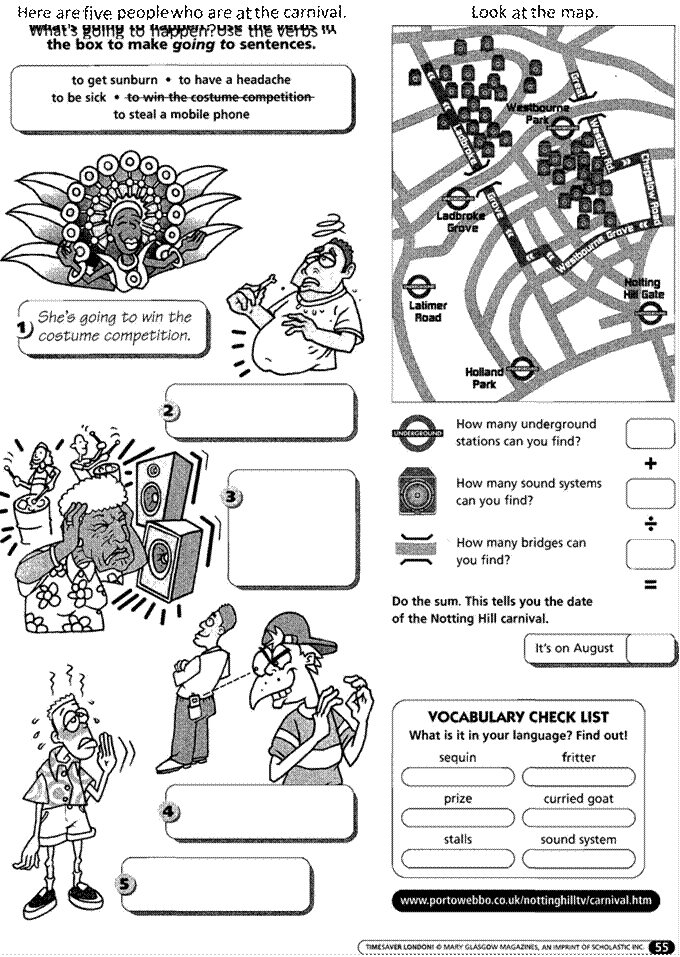
TIMESA VER LONDON! a great deal of; a couple of; plenty of; a few; several; a bit of; allowed to
|
|
Film It's a bit a special allowed to |
London Cinemas scary - so are you allowed to see it? Each film has
'certificate' which means only certain people are
22 million people visit Leicestersee it. Match the certificates to the definitions:
(pronounced 'Lester') Square a) You are not allowed to see it if you
U certificate
every year. It's near Piccadilly are younger than fifteen
Circus and there are several big b) You are not allowed to see it if you cinemas in the square itself plus PG certificate are younger than eighteen lots more nearby.
12A certificate c) Everyone is allowed to see it You can go to Leicester Square when there's d) Children under twelve are not a première* of a big new film and you will allowed to see it unless they are 15 certificate
see plenty of famous film stars walking accompanied by an adult along the red carpet* to the cinema. You'll
e) Children under twelve are allowed see lots of photographers and you might 18 certificate
to see it if their parents think it's OK even pick up* a bit of celebrity* gossip*.
Here are some famous British actors. Take the two letters after their names and put them in the correct order to discover the title of a successful
British film.
|
n |
ag VOCABULARY
What is it in your language?
Find out!
Which British actor... had a few scary moments in cold première has been in a few Star Wars films? water with Leo DiCaprio?
Ewan .M.QG.r.e.ø.Qr..![]() carpet
carpet
has spent a great deal of time in . wore a couple of pointed ears in
Hogwarts School? three very successful films? to pick up
celebrity has got lots female fans because his has had plenty of experience of name is "Bond, James Bond"? playing a shy, aristocratic Englishman?
gossip
The name of the film is:
http://movies.yahoo.com/upcoming
![]()
London is a great place to hear live music.
These famous
British pop stars are all singing about the future in their hit songs. Fill in
the missing words, and take the correct letter to spell the name of London's
most popular rock concert venue. Choose from these words: ![]()
|
YOU • IMPOSSIBLE • MAYBE • SAVES • HEART DREAM • WITH • MAN • I'LL • FEED • STRONG • AT |
|
Though the sea will be . .. STRONG |
|
Well, I won't go down |
|
|
I know we'll carry on, 'cos if there's somebody calling |
|
And I won't put up my hands and surrender* |
|
|
me on; she's the one. |
|
(first letter = |
) |
|
(third letter = ... R.... ) She's the One (Robbie Williams) |
|
White Flag (Dido) |
|
|
|
19 |
Every bond* you break, |
|
|
Give me just a second and I'll be alright |
|
Every step you take, |
|
|
Surely one more moment |
|
I'll be
watching |
|
|
couldn't
break my |
|
(first letter = |
) |
|
(second letter = ........... ) Gotta Get Thru This (Daniel Bedingfield) |
|
Every Breath You Take (Sting) You're gonna be the one who |
|
|
Will you still need me, |
|
And after all, you're my wonder wall. |
|
|
will you still |
|
(second letter = ..... ...... ) |
|
|
When I'm sixty-four? (third letter = ... ... ..... ) |
|
Wonderwall (Oasis) |
|
|
When I'm Sixty-four (The Beatles) |
|
For now But baby, if you change your mind, don't be late, |
|
|
I'm flying high, |
|
(third letter = ..... ...... ) |
|
|
like the
wind, reaching the |
|
Whole Again (Atomic Kitten) |
|
|
(tenth letter = ) Anything is Possible (Gareth Gates) |
|
ooooooo 9 3 6 7 12 2 10 |
|
|
And I think it's going to be a long, long time to find |
|
00000 |
|
![]()
![]() Till
touchdown* brings me round again
Till
touchdown* brings me round again
I'm not the ![]() they think I am at home.
they think I am at home.
(third letter = .... ... .... ) Rocket Man (Elton John)
![]() 6 You'll always be the
6 You'll always be the![]() that fills my head
that fills my head
(fifth letter )
Never had a Dream Come True (S Club 7)
Wanna take my
time for me, all me so ![]() tomorrow I'll find my way home.
tomorrow I'll find my way home.
(fourth letter ..... ...... )
Maybe Tomorrow (Stereophonics)
![]() Look
Look ![]() the stars, look how they shine for
you
the stars, look how they shine for
you
And all the things that you do.
(first letter = ..... ...... )
Yellow (Coldplay)
past perfect tense; too + adj + infinitive / not + adj + enough + infinitive
Every July, 100,000 people go to Hyde Park in London for the Party in the Park.
Pop stars from all over the world take part in a concert to raise money for the Prince's Trust. In 2003 the Party in the Park raised £1 million, but the Prince's Trust needs to raise £53 million every year. Why? And what is it?
|
people who join the projects are helped over half a million young people. ambitious enough, they can sometimes If you are between 18 and 25 and if you get help from the Prince's Trust to start have musical talent, you can go on a their own small businesses*. The Trust one-week music course organised by the helped two ex-prisoners to start a fishing Trust. You learn how to set your own club; it helped to train lifeguards* on the music goals, play new styles, play in a beaches in Cornwall, and it built a band, perform 'live' on the last night of community centre on a poor housing the course, and you get specialist estate*. Since 1976, the Prince's Trust has instrument tuition*. It's very popular. |
|
Who's that girl? 1 She's a singer. 2 Her birthday is on 21st January. 3 She's a Prince's Trust Ambassador. 4 She used to be in a famous pop group. 5 She's met Nelson Mandela. 6 One of her best friends is married Prince Charles always goes to the Party in the world-famous footballer. to a Park and sits with the performers. Who did he next to a few years ago? If you guess after 7 She's got blonde hair. one clue, give yourself 10 points. If you guess 8 She's very rich. after two clues, give yourself 9 points, after 3 9 Her nickname used to be Baby. |
![]()
sit
clues 8 points, etc. Don't cheat! Now make up 10 clues about another famous person. See if your friends can guess who it is.
10 Her friends' nicknames were
Ginger, Sporty, Scary and Posh.
VOCABULARY
CHECK LIST What is it in your language? Find out! skilful
potential
in trouble
experience
disadvantaged
small business
lifeguard
housing estate
tuition
![]()
www.princes-trust.org passives; , numbers and dates
It takes place on the second Saturday in November every year. Half a million people usually watch the procession* on the streets and three million people watch it on TV. It was the first event* to be broadcast 'live' on television.
During the Show, the new Lord Mayor is taken from eighteen horse-drawn carriages. There are fireworks
the Mansion House in the centre of the City of London, past St Paul's Cathedral built by Sir
Christopher Wren, and on to the Law Courts in the
Strand. There he makes a promise* to serve the Queen faithfully* for his year as Mayor, and then returns to the Mansion House.
There is always a splendid procession. Four hundred years ago a camel walked in the procession when the Mayor went to meet Queen Elizabeth l. The State
Coach (the beautiful golden carriage* carrying the Lord Mayor) is preceded by two hundred soldiers, two hundred horses and sixty-five floats (big lorries with people in carnival costumes). Forty-three tonnes of sand are put on the streets to protect* the horses' feet. There are also sixteen marching bands and
![]()
The Lord Mayor's Add the following numbers:
in the evening. The State Coach was built in 1757, but there has been a Lord Mayor of London (and a Lord Mayor's Show) since 1 189. You can read about it in three of Shakespeare's plays, and Canaletto and Hogarth both painted the procession.
Dick Whittington Samuel Pepys
|
Read these statements about Dick Whittington and match the correct question tags to each one. Look at the alphabet letter |
Match up the halves of these words and then find where they go in the text about this legendary Londoner. The numbers on each half combine to make a new number between 11 and 21. |
in front of each question tag
Look at the alphabet key and and put it in the space over the then put the letters in the correct correct number in the TAG BOX places in the text and they will to find the name of the hill spell out the name of the street where Dick Whittington heard where the Fire of London started. the church bells.
1 Dick was born in the 1350s, ....Wâ6tq't he? 1 BE 6 ARY
|
|
MAR |
4 |
OUS |
= L |
= 1 |
|
Dick gave Mr Fitzwarren his cat instead*, and asked |
-SE¥Ee+ |
2 |
CAME |
= A; |
= D |
|
him to sell it. Then Dick decided to return to |
DES |
9 |
OPLE |
= E |
|
2 He went to London to find work, 5 TROYED
|
3 He didn't have any money, |
1 FAM |
7 EAT |
Alphabet key |
|
4 Mr Fitzwarren asked Dick to invest* money in a |
1 |
1 RIAGE |
1 1 = D; 12 = N |
|
sailing voyage, but Dick wasn't a rich man, |
2 |
|
14 = G, |
|
|
1 |
o UTION |
15 = N; 16
= U |
![]()
![]() Gloucester, but the
church bells started ringing,
Gloucester, but the
church bells started ringing,
6 The
bells were speaking to him, saying: "Turn again, Whittington!" So
Dick turned round and went back to London where he found that Lord Fitzwarren's
ship had returned from its voyage. There had been thousands of rats in one of
the countries it had visited,![]()
7 The brave cat had killed all the rats and the reward*
was huge, ![]() . So at last Dick
. So at last Dick
became rich and married Alice Fitzwarren. He was Lord Mayor of London three times and he left all his money to the poor people of London when he died.
8 We all know this story because there is a famous pantomime based on it,
H - didn't he? T - didn't they?
TAG
E - isn't there?
BOX
G — hadn't there? I - was he?
A- did he? G - wasn't it? 000@oooa
2 4 7 1 6 3 5 8
Sherlock Holmes
Arthur Conan Doyle invented* the character of Sherlock Holmes in 1887. He wrote sixty stories about his famous detective and his friend Dr Watson between 1887 and 1927. He even tried to 'kill' Holmes in 1893, but all the readers protested and he brought him back again in 1901 for a story called
The Hound of the Baskervilles.
Look at these four groups of objects. Which group comes from 221B Baker Street? Under each group of objects write either:
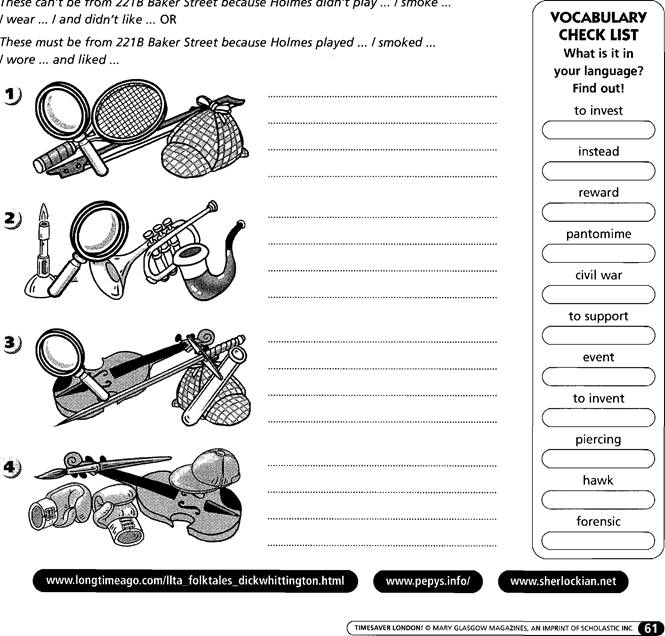 These
can't be from 221B Baker Street because Holmes didn't play ... / smoke ...
These
can't be from 221B Baker Street because Holmes didn't play ... / smoke ...
What is a Cockney? works by having two words or a also by criminals* who didn't want Most people think that a Cockney phrase. For example: Daisy Roots the police to know what they is anybody who is from or lives in boots). The last word in the pair were talking about. Because the London, but this is not true! rhymes with its meaning, Roots = police had to understand this
Cockney traditionally means a Boots. code, they had to write it down, Londoner who lives within five However, to make this more and that is how it became widely miles of St Mary's Church in Bow, confusing, the rhyming slang is known.
East London. often shortened to the first word Some Cockney rhyming slang is in the phrase. For example: Where common all over the UK. Here are What is Cockney are my daisies? two examples:
rhyming slang? Cockney rhyming slang is Are you going to rabbit all night!
Cockney rhyming* slang is a slang confusing for a reason. It was used (Rabbit and pork = talk) form of language from London. in the 1800s as a code by East End Use your loaf and think next time!
Most Cockney rhyming slang London street traders* and then (Loaf of bread = head)
|
|
Body parts? |
Cockney rhyming slang today |
|
|
Can you label the parts of |
Cockney rhyming slang has recently become fashionable with |
|
|
the body on this person using |
many young people in the UK, perhaps because it was used in |
|
|
Cockney rhyming slang? |
two gangster* movies Lock Stock and Two Smoking Barrels and Snatch. In fact, many young people have started making up |
|
1 |
Hampstead Heath |
their own modern rhyming slang. It makes them look cool, and |
|
2 |
Mince pies |
like the criminals and street traders before, allows them to talk |
|
3 |
Plates of meat |
about things without their parents or teachers understanding. |
|
4 |
Ham and eggs |
Modern rhyming slang often uses the names of famous people. |
|
5 |
Boat Race |
Here are three examples. Look at the sentences below. What do you think they mean? |
1 Britney Spears
Fancy coming?
Meaning =
2 Tony Blair
Hey, nice Tony. Did you get it cut?
Meaning =
3 Claire Rayner
(She's a popular agony aunt in the UK - a person who answers people's problems in magazines.) Wow! You've got new Claire Rayners. Are they Adidas?
Meaning =
www. cockneyrhymingslang.co.uk
VOCABULARY CHECK LIST What is it in your language? Find out! to rhyme
trader
criminal
gangster
|
The British Museum Put the correct compound adjectives which are missing from the text into the grid to learn the name of one of the most famous exhibits in the British Museum. |
The British Museum is the oldest museum in the world and it covers two million years of world history and culture. Its (1) collection of statues, carvings, mummies* , jewels and coins makes it a number one attraction for tourists. It has taken scholars many years to decipher* the (2) .
hieroglyphics (pictures and symbols) on the Egyptian tombs. Amongst the British exhibits from the first century A.D. is Lindow Man, the
(3) body of a man which was found in a bog*. Lindow Man was poor, unlike the
Egyptian mummies which are (4) and surrounded by expensive possessions. From Roman
Britain there is a wonderful (5) .
mosaic floor; from the twelfth century, the Lewis chess men are probably the Museum's
(6) items; they are on lots of postcards and you can buy copies of them in the Museum shop. In the African galleries you can see a beautiful (7) Nigerian head
of a woman. But most people's favourite items are the mummies. The Egyptian queens have
(8) names such as
Seshepenmehit. Their bodies were found in ornate
(9) coffins deep inside the
1
2
3
4
5
6
7
8
9
10
11
12
well-dressed • multi-coloured • well-read hand-carved • strange-looking • hard-working ginger-haired • gold-painted • well-preserved best-known • unusual-sounding • world-famous
Pyramids which were built by thousands of slaves*. The most famous Egyptian in the British Museum is nicknamed* 'Ginger' because you can still see the original skin and hair on this 5,000-year-old (1 1) farmer whose body was found in the sand along with his burial goods. If you don't like dead bodies, you can visit the
Reading Room where some of the world's most
thinkers, writers and philosophers such as Karl Marx, Ghandi and Dickens used to sit and study.
VOCABULARY
CHECK LIST
What is it in your language? Find out!
mummy
to decipher
bog
slave
to nickname
The . is a wonderful treasure from the year 196 B.C.
![]() The text in three
'languages' (Hieroglyophics, Demotic and Greek) honours Ptolemy, the Pharaoh at
that time. It was discovered in 1799.
The text in three
'languages' (Hieroglyophics, Demotic and Greek) honours Ptolemy, the Pharaoh at
that time. It was discovered in 1799.
2nd conditional
Hampton Court
|
If you could travel in time |
roast peacock* would probably be on |
CHECK LIST |
|
and return to the sixteenth |
the menu for dinner. You would be able |
What is it in |
|
century* , you would probably* |
to visit the famous maze* which still |
your language? |
|
like to visit Hampton Court |
exists* today. It's as much fun getting |
Find out! |
|
Palace which is west of London |
lost in the maze now as it was then. |
century |
|
and on the banks of the River |
Henry Vlll is famous for having six wives. |
|
|
Thames. If you did, you would |
|
probably |
|
see that things were very |
Elizabeth I |
|
|
different in those days. You |
Elizabeth went to live in Hampton Court |
to marvel |
|
would be surprised how busy |
Palace one year after she became queen |
|
|
the River was, and of course, |
in 1558. She spent Christmas at the |
|
|
there were only a few roads |
Palace and life was wonderful. They all |
deer |
|
and you would only see people |
enjoyed banquets, balls, plays, music, |
|
|
on horses or going on foot |
dancing, tennis, shooting and hunting. |
|
|
along them. You would be able |
The Great Hall of the Palace is the oldest |
|
|
to marvel* at the huge parks |
theatre in England. Explorers* such as |
fit for |
|
around the Palace and the |
Sir Walter Raleigh and Sir Francis Drake |
|
|
deer* walking in them (although you can still see |
were often guests of Elizabeth. |
peacock |
|
them there today!). |
Later Years |
|
|
|
The Palace continued to have an interesting history. Sir Christopher Wren |
maze |
|
Henry Vill |
built some new parts and both Charles I |
to exist |
|
Thomas Wolsey built the Palace with its |
and Oliver Cromwell lived there. Samuel |
|
|
280 guest rooms and he then had to |
Pepys was a regular visitor, and rich |
explorer |
|
give it to Henry Vlll as a present! As a |
people went there to escape the Plague |
|
|
time traveller, you would see long |
in 1665. |
beware of |
|
galleries* , beautiful paintings, libraries |
If you visited it today, you would be |
|
|
full of books, a chapel, and 500 servants |
astonished at how magnificent it still |
|
|
rushing everywhere preparing meals 'fit |
looks...but beware of* the |
|
|
for* a king'. Roast deer, roast swan and |
ghost of Kathryn Howard! www.hrp.org.uk/webcode/hampton_home.asp |
|
VOCABULARY
past , tense
This is the rhyme which we use to remember what happened to Henry's wives:
Divorced, beheaded, died;
Divorced, beheaded, survived.
Read the text and see if you can identify each of the queens.
|
Anne of Cleves was only married |
1 |
She married Henry in 1509; |
|
|
to Henry for a few months. Neither Katherine Parr nor Anne |
|
she was divorced in 1533. |
|
|
Boleyn were Henry's first wife. |
2 |
She married Henry in 1533; |
|
|
Jane Seymour died after giving birth to Henry's son, Edward. |
|
they cut off her head in 1536. |
|
|
She wasn't his last wife. |
|
|
5 She married Henry in 1 540; |
|
Anne Boleyn and Kathryn Howard |
3 |
She married Henry in 1536; |
they cut her head off in 1542. |
|
were executed. Catherine of Aragon was married |
|
she died in 1537. |
|
|
to Henry for twenty-four years. |
|
|
6 She married Henry in 1543; |
|
|
4 |
She married Henry in 1540; she |
she died in 1 548. (Henry died |
|
Kathryn Howard was married to Henry for two years. |
|
was divorced in the same year. |
the year before.) |
Anne of Cleves
Using the same numbers for the six wives as above, which wife would you find if you followed these instructions?
![]() Go to the centre of
the maze.
Go to the centre of
the maze.
Follow the path out and around. When you have to make a choice between left or right, choose right.
Follow the path round the corner and she is standing in front of you.
The London Dungeon is near London Bridge. It's London's scariest museum. It tells people about London's darker past. Although it's scary*, you can also learn a lot about history, including Boudicca, the Great Plague and Jack the Ripper.
In AD61 thousands of Roman soldiers and their families were living in Britain. Boudicca (sometimes called Boadicea) was queen of the Iceni, an English tribe*. She led the Iceni in a revolt* against the Romans. She was very brave, but her tribe lost the war. The Iceni burned three cities including London.
In 1665 more than 100,000 people died in the Great Plague*. The disease was carried by fleas* which lived on black rats. The rats came off ships which sailed into London. It wasn't known how the disease was passed from one person to another. At first it was thought that all the dogs and cats in the city were to blame* , so 40,000 dogs and 80,000 cats were destroyed. However, the problem was made worse because the fleas jumped straight from the rats onto people! Rich people were advised to leave London and move to their country houses to avoid* the Plague. One third of all those people left in London died. A red cross was painted on the door of each house where it was known that there was a person dying of the Plague. All the dead bodies were taken and buried in large Plague pits*. Men with carts walked through the streets, and the shouts of "Bring out your dead"' were often heard.
One of London's scariest inhabitants was Jack the Ripper. The streets of London used to be very dangerous in Victorian times because there was a lot of poverty*, homelessness* and crime* especially in the East End near Whitechapel. Five women were brutally* murdered in ten weeks in
1888 by a man known as 'Jack the Ripper'. 600 policeman tried to solve the crime, but he was never caught. Several famous people were suspected* including Queen Victoria's son, the Queen's doctor and Walter Sickert, a well-known artist.
VOCABULARY
CHECK LIST What is it in your language?
Find out! scary
tribe
revolt
plague
flea
blame
to avoid
pit
poverty
homelessness
crime
brutally
suspect
![]()
www.thedungeons.com
Many theories have been put forward about the identity of Jack the Ripper.
Choose the correct verb to complete each sentence below, and join the appropriate dots on the grid. It will spell a word.
|
writer, is known (6 - 9) / is convinced ((íÛ) that the Ripper was Walter Sickert, the artist. She
has even spent her own money on DNA tests Some letters were sent (1 1 - 1 2) / were brought (4 — 7) to the police by the Ripper but others were fakes, written by journalists. One letter was signed (3 - 6) /
was chosen (1 1 — 13) with the words: "Catch me if you can." The Ripper was told (9 — 11) / was described (1 — 2) by witnesses as being a short man with a beard who spoke with a foreign accent. Queen Victoria's son, was inspected (5 - 8) / was suspected (12-14) of being the Ripper. 7) There was a rumour that he had been married (5 - 6) / has married (13-1 6) in secret to a working-class girl in Whitechapel. 4 7 9 |
persuaded (8 - 10) / was given (2 - 3) to kill the girl's five friends to keep the secret safe. 9) The doctor had been blessed (7 - 9) / had been knighted (7 - 8) by the Queen, and received the title 'Sir'. His first name was William. People say that he wanted the marriage to be taken (5 — 7) / to be kept (1 - 4) secret because the girl had had a baby. Jack was spoken (3 - 4) was called (2 - 5) 'the Ripper' because he ripped (cut) the bodies of his victims. Another suspect was a schoolteacher called Druitt, but his body was found (9 - 10) / was appeared (1 — 5) in the Thames in December 1888. If the dots below have been joined (15 - 16) / have been left (1 1 - 14) correctly, you can see the surname of the royal doctor. You already know his first name and his title. 11 13 |
![]() 9)
9)
O)
3 6 8 10 12 14 15 16

![]()
The Palace of Westminster, as it used to be called, is one of the oldest buildings in London. It's now the centre of British politics*. Complete the multi-word verbs in the text using words from the list.
at • on • place • out on • at • -about- • after place • on • up • around down • up • up • around up • on • away • down
How Did it All Come (l) . ..A.bout ?
In 1014 the Anglo-Saxons and the Norwegian Vikings sailed (2) the River Thames. Danish Vikings stood (3) London Bridge and threw spears* and stones (4) them, but the Norwegians pulled
(5) roofs from houses to protect their boats. They used ropes to pull the bridge down. Finally, after many battles, a fierce Danish warrior* called Canute became King of England in 1016. He called (6) everyone to live in peace. After he died, King Edward the Confessor carried (7) with his good work and built London's first great building*: Westminster Abbey. An earlier church (St Peter's) stood (8) the site* before. While the new Abbey was going (9) Edward could look (10) it from his home - the Palace of Westminster which was nearby. Sadly, he passed . a week after the Abbey was finished.
Re-building the Abbey
200 years later, Henry Ill pulled it (12) and built a new abbey. Monks looked (13) the farmland around it and grew herbs* (for medicine). You can still go (14) the 900-year-old Abbey garden.
Every king or queen since William the Conqueror (1066) has been crowned in the Abbey. The last royal coronation* took (15) in 1953. Lots of kings, queens and other famous people are buried there too. When Henry V died, his battle horses were led (16) to the altar* with his body. Visitors can walk (17) the Abbey when there are no church services and can see the memorials put (18) to people like Shakespeare and Chaucer.
The Houses of Parliament
Royal Christmas feasts* , coronation banquets and trials* have taken (19) in Westminster Hall which is the oldest part of the palace still remaining. In 1834 a terrible fire wiped (20) a lot of the old palace. It was rebuilt, and contains 1,000 rooms. It contains the House of Commons (the main parliament) and the House of Lords where people with noble titles (Lord, Lady, Sir, etc) discuss laws
VOCABULARY CHECK LIST What is it in your language? Find out!
politics
spear
warrior
building
site
herbs
coronation
altar
feast
trial
suggested by Members of Parliament in the House of Commons. www.bonfirenight.net/index.php
![]()
Guy Fawkes and the Gunpowder Plot
Guy Fawkes was one of the group of men who plotted to blow up the
King James to be more tolerant to Catholics. One plotter sent a letter to warn a friend not to go the Houses of Parliament. The King found out and his guards searched the cellars of Parliament and found Guy Fawkes.
|
Go through the maze joining up the |
|
||||
|
multi-word verbs which complete the |
It was late at night when Guy Fawkes . to |
||||
|
sentences. If you join them up correctly |
the cellars of the Houses of Parliament. He looked round for |
||||
|
and take the alphabet letters in the corners of the squares you will see the |
somewhere to sit. At first he . on one of the |
||||
|
name of the leader of the plotters. |
barrels, but then he felt tired so he - on the floor. He fell asleep for a few minutes but when he heard a noise. He . quickly and hid behind a barrel. A voice . "Who's there?! " Suddenly a group of guards .. and one of the barrels. They the corner and saw something move. Guy almost . as he tried to but they him and caught him. He was . tortured and executed and a few days later all the other plotters were caught and killed too. Now English people burn a 'guy' on a bonfire each November 5th to remind everyone of that moment |
||||
|
START |
|
||||
|
in history. |
|
|
|||
|
went |
sat |
lay |
lay |
put |
|
|
down |
down |
down |
in |
on |
|
|
got |
got up |
woke |
off |
sat |
|
|
passed |
called |
called |
came |
carried |
|
|
out |
out |
on |
|
|
|
|
gave |
burst |
knocked |
came |
ran |
|
|
up |
in |
over |
round |
after |
|
|
came |
broke |
brought |
|
run |
|
|
across |
down |
up |
over |
|
|
used to
London has more parks and big gardens than almost any other capital city.
Put the correct missing words in the sentences and then put the words into the trees and you can find the name of the London park which has an open air theatre. During the summer you can watch Shakespeare's plays when it isn't raining.
Hyde Park
Hyde Park is the 1 largest. . central
London Park. It used to be a royal hunting forest and sometimes 2 used to go there to 3 .
duels*. There's a big lake in the middle of Hyde Park called the Serpentine. Some people swim in the Serpentine on Christmas Day.
Kensington Gardens
Part of the lake is in Kensington Gardens. 4 wild bulls* and wild
boar* used to live there a long time ago. Speakers' Corner is in Hyde Park near
Marble Arch. It's a place where
5 . can go to make a speech on a Sunday afternoon. There's a 6 of Peter Pan in the park
and also a tree full of carved* elves* called The Elfin Oak.
There is an old French game called paille maille. It's like croquet* and Charles Il used to play this game in St James's Park. The road next to it is now called Pall Mall.
Tree 1
Regent's Park
Regent's Park also used to be a hunting forest. Over one hundred 7 ago people used to 8 things on canals.
Holland Park
Holland Park is a pretty little park near Notting Hill and it's full of bluebells* in spring time.
Richmond Park King 9 the First
used to enjoy hunting and he made Richmond an enclosed* park in 1632. It's one of the largest enclosed parks
in 10 There are 600 deer in this huge 11 and ducks and swans on the ponds. 600,000 years ago lions and rhinoceroses used to live there.
Tree 2
|
statue years people anyone fight transport |
park Britain Charles wolves |
VOCABULARY CHECK LIST What is it in your language?
Find out!
duel
bull
boar
carved
elves
croquet
bluebell
enclosed
www.royalparks.gov.uk
![]()
Pick the correct passive verbs in the text to discover what has made the ten British artists on the bottom half of this page famous.
Most people 1
....ar.e...ve.ry..j.mp.reseed are very interested (j) / are-veg Tate
Modern impressed (f) by the amount of art on display in London. The
National Gallery in Trafalgar Square has one of the largest collections of
pictures in the world. Paintings by Da Vinci, Titian, Velasquez, Holbein and
many others 2 ![]() are exhibited (c) / are extended (a)
there. The National Portrait Gallery 3 .
are exhibited (c) / are extended (a)
there. The National Portrait Gallery 3 .![]() has found itself (i) /
is situated (a) just around the corner from the National Gallery. Tate Britain
is on the River Thames and it's near the Houses of Parliament. There are a lot
of modern paintings there as well as pictures by Turner and Constable, but many
of the very recent ones 4 ..
has found itself (i) /
is situated (a) just around the corner from the National Gallery. Tate Britain
is on the River Thames and it's near the Houses of Parliament. There are a lot
of modern paintings there as well as pictures by Turner and Constable, but many
of the very recent ones 4 ..![]() have been borrowed (j) / have been taken
(g) to Tate Modern. Tate Modern used to be a power station with a gigantic
turbine* hall which is now a gallery, and it's
have been borrowed (j) / have been taken
(g) to Tate Modern. Tate Modern used to be a power station with a gigantic
turbine* hall which is now a gallery, and it's
5 . linked (h) / lined (b) to St Paul's
|
1 Stubbs (1724-1806) |
a) his paintings of sea, sky, ships |
VOCABULARY |
|
is best known for |
and landscapes |
CHECK LIST What is it in |
|
2 Constable (1776-1837) |
b) his paintings of ladies in big |
your language? |
|
is best known for |
long dresses with large curly |
Find out! |
|
3 Turner (1775-1851) |
silver wigs |
turbine |
|
is best known for |
c) his paintings of English country |
|
|
4 Blake (1757-18270 |
landscapes |
wobbly |
|
is best known for |
d) his paintings of British northern |
|
|
|
industrial towns full of |
responsible for |
|
5 Hogarth (1697-1764) |
'matchstick* men' |
|
|
is best known for |
e) his paintings of Californian |
matchstick |
|
6 Gainsborough (1727-1788) |
swimming pools and 1960s people |
|
|
is best known for |
|
mystical |
|
7 David Hockney (1937-) |
f) his paintings of horses |
|
|
is best known for |
g) his mystical* religious paintings |
satirical |
|
8 Lowry (1887-1976) |
h) his satirical* drawings of 18th |
|
|
is best known for |
century London life |
|
www.nationalgallery.org.uk
allowed to; irregular past tense
Many of the pubs in London have been there for hundreds of years.
The 'club scene' is more recent. You can dance to all kinds of music: garage, techno, hip hop and rock. Many of the clubs have age limits* and rules about how you are allowed to dress.
|
You are not allowed to buy an alcoholic drink in |
closes. You aren't allowed to take children into a |
agreed |
|
a pub if you are under eighteen. Recently* the |
pub unless the pub has a restaurant. Some pubs |
fell |
|
laws have changed and some pubs are allowed |
have beer gardens and families are allowed to |
stood |
|
to serve drinks all day. Before the pubs close, the |
sit outside. People enjoy sitting round a table |
was |
|
landlord* shouts, "Last orders!" and people are |
with a drink telling jokes and clever stories like |
smiled |
|
allowed to buy one more drink before the pub |
this one. Put the correct verbs into the spaces. |
poured |
came
A philosophy professor (1) before his class and
(2) filling a large glass jar with rocks. The students (3) that the jar (4) full. So the professor (5) and picked up a box of small pebbles* and poured them into the jar. The pebbles, of course,
(6) into the small spaces. Then the professor (7) a box of sand into the jar, (8) it, and the sand completely filled the jar.
"This jar represents your life, " said the professor. "The rocks are the important things - your family, your health; if you
(9) everything else, your life would still be full, The pebbles are the smaller things that matter — your job, your house, your car. The sand represents the trivial* things. If you put the sand into the jar first, there is no room for the pebbles or the rocks, just like life. Take care of the rocks first— the things that really matter. The rest is just sand. "
Then a student (10) to the front of the class and poured a can of beer into the jar and it was easily absorbed*. The moral of this tale is: No matter how full your life is, there is always room for beer.
Ae 017
Cheshire
Cheese
[BUILT 1661
VOCABULARY
CHECK LIST What is it in your language? Find out! limit
recently
landlord
pebble
trivial
to absorb
www.pubs.com
|
Greenwich The best way to visit Greenwich is to go by boat from Westminster pier. Greenwich is the home of the National Maritime Museum |
The National Maritime Museum (designed by Sir Christopher Wren) has got a big collection of maps, manuscripts, models of famous ships and portraits of famous sailors and explorers.
The Royal Observatory was built in 1678 to solve the problem of finding longitude - a ship's exact position east and west while at sea and out of sight of land. Early sailors used the stars to help them navigate and they could tell the time from the position of the sun.
However, they needed to know
and the Royal Observatory.
what the time was at a fixed reference point* because time moves forwards and backwards every 1 50 one travels (east or west). Clocks were not accurate* at sea, and each country had its own zero meridian*. In 1884, at a conference in Washington, USA, most countries in the world agreed to make Greenwich the source* of the prime* meridian (00).
You can also find out about the night sky at the planetarium in Greenwich.
Put the times on the clocks and use the semaphore code to find out a fact about a very cold planet.
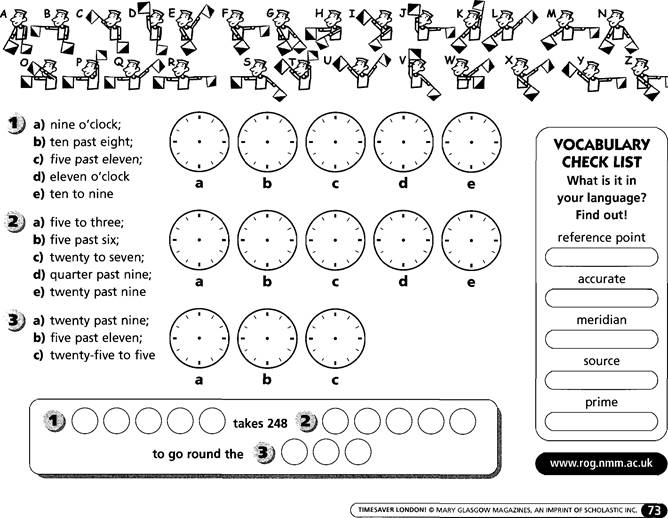
Charles Dickens was born in Portsmouth in 1812 and died in London in 1870. He is buried in Poets' Corner in Westminster Abbey.
Dickens spent most of his life in London and often used to walk between ten and twenty miles* all over the city when he was unable to sleep and was thinking about the plot of a new novel. While walking, he used to observe the sights, sounds and smells of London in order to write about them. In 1800 there were one million people in London, but by 1880 there were four and a half million! Because of the Industrial Revolution, Britain, and especially London, grew very quickly.
People used to travel through the streets of London in horse-drawn carriages. Every hour at least one thousand carriages crossed London Bridge, so there used to be a lot of mess* on the streets from the horses!
London used to be a terrible place for poor people, especially children. In 1839 nearly half of all the funerals* in London were for children under the age of ten. Those who survived had little or no education and Dickens believed that education was the way to break the cycle of poverty as it had done for him. In his books he used to expose all
CHECK LIST What is it in your language? Find out!
mile
mess
alley
beggar
thief
funeral
social
installment
soap opera
www.fidnet.com/—dapl 955/
these awful social* problems. www.dickens/dickens' london map.html
Dickens' novels
A number between 1 and 3 (P4)
Shared by two or more people (H2)
Miserable, gloomy (B 1)
A place where you buy things (1<4)
An organ which takes poison from the body (A2)
English name for the Christmas saint (J 1)
You use a timetable to find the - of trains (Q)
A reddish-brown coloured metal (N2)
To think something is going to arrive (02)
A verb often confused with make (M2) Farm building where cows live (DI) Preposition meaning near or next to (D3)
A girl's name and Christmas song (1.3)
A meadow where cows live (N3)
Preposition meaning near or next to (J3)
Pages of a book are made from it (13) Fibre or cord in a candle which burns (12)
A conjunction, eg fish — chips (O)
A fascinating object or desire to know things (1<3)
A big December holiday (1.2)
Where people live (B2)
Definite article (K 1)
Indefinite article (PI ) Humour (F4)
Short for Edward (El)
Large towns (P5)
A pal (H3)
I (04) OOD (E4) s (06)
Opposite of new (1<2)
Short for Doctor (E3) A cheap metal (F2) story (P2) MAR (Fl)
Opposite of lose (Q)
MBEY (Q)
A cup - tea (P3)
Very big (01)
Opposite of big (Ml)
RUDGE (D4)
Mother, father, daughter ![]() O (Al)
O (Al)
To turn (A3)
How do you - ? (C 1)
A (D2)
CHUZZLE (F3)
I get up — seven o'clock (03)
I sleep late — Sundays (05)
DAVID (NI)
RRIT (M3)
NICKIE 02)
Belonging to us (HI )
To take or choose (Il)
Pages 8 & 9 Buying a travel card I ticket.
Arriving in London Tourist: A one-day travelcard to London, please.
1 1 Heathrow, 2 Gatwick, 3 Luton, 4 Stansted, 5 City (Not please a one-day travelcard)
Travel assistant: That's £4.90 please.
2 You go to passport control
Tourist: Here's £5.00.
3 You go to baggage reclaim
![]() Travel assistant:
Thank you. Here's your ticket and change. Tourist: Thank you.
Travel assistant:
Thank you. Here's your ticket and change. Tourist: Thank you.
Pages 12 & 13
Going by Tube
1 — Central, 2 - Circle, 3 — Piccadilly, 4- Victoria,
5 — Northern, 6 — District, 7 — Bakerloo,
8 — Hammersmith and City, 9 — Jubilee, 10 — Metropolitan, 1 1 - Waterloo and City, 12 — Docklands Light Railway
Finish these sentences:
5 You go to the Exit Pages 14 & 15
6The London Eye
|
Name of airport |
Where do you arrive? |
How long does it take? |
How much does it cost? |
|
Heathrow |
Paddington |
15 mins |
|
|
Gatwick |
Victoria |
30 mins |
|
|
Stansted |
Liverpool Street |
45 mins |
|
|
Luton |
London Bridge |
30 mins |
|
A great view!
1 Trafalgar Square, 2 Tower Bridge, 3 Big Ben, 4 St Paul's Cathedral, 5 A black taxi
How much does it cost?
1 £16.50, 2 £100.00, 3 £20.00, 4 £22.00, 5 £40.00
Pages 16 & 17
The Tower of London
Numbers search
A = three hundred (in the Crown Jewels paragraph)
Pages 10 & 11 B = seven (in the ravens paragraph)
London transport C = nine hundred (in the introduction) Help the tourist! D = forty (in the Beefeaters paragraph)
1 = bus 1 e,
2 = bus 88 c, 3 = bus 42 d, ![]() bus 159 b,
bus 159 b, ![]() bus 1 1 a Escape from the Tower
bus 1 1 a Escape from the Tower
![]() Travelcard
Travelcard 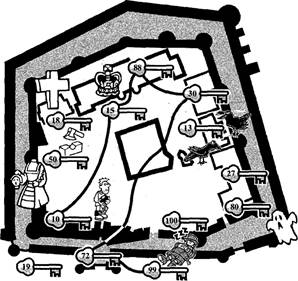
Pages 18 & 19
The River Thames
Frogtours
![]()
Pages 20 & 21
London Football Clubs
Which player?
1 = David James; 2 = David James; 3 = David James;
4 = Hernan Crespo
Mascots
![]()
Football chants:
1 Chelsea; 2 Tottenham; 3 = West Ham
Pages 22 & 23
Madame Tussaud's
1 George Bush, 2 Kylie Minogue, 3 David Beckham,
4 Jennifer Lopez
In the modelling room
1 It's the Queen's hair. 2 It's James Bond's arm. 3 It's Charlie Chaplin's moustache. 4 They're Marilyn Monroe's legs.
Page 24
Buckingham Palace
![]()
Page 25
The London Butterfly House
Find the butterflies
![]()
Pages 26 & 27
Hamleys
Which floor? 1 fifth floor, 2 basement, 3 first floor, 4 third floor,
5 second floor
Speaking
1 basement, 2 second floor, 3 first floor, 4 first floor, 5 ground floor and third floor, 6 the ground floor and the fifth floor
Pages 28 & 29
Harrods
Rules of the shop
1 can't, 2 can't, 3 can, 4 can't, 5 can, 6 can't
Problems, problems 1 It's too big.
2 They are too short.
3 My mother already has one of these.
4 It's got a hole in it.
5
Take it back
Shop Assistant: Can I help you?
Customer: Yes, it's this jumper.
Shop Assistant: OK. What's the problem with it?
Customer: It's too big
Shop Assistant: Would you like an exchange or refund? Customer: I'd like an exchange. I'd like this jumper in a smaller size.
Shop Assistant: That's fine. Have you got the receipt? Customer: Yes, here it is.
Pages 30 & 31
London's Markets
![]()
At the market
1 is £10.00, 2 is £25.00, 3 are £1.50, 4 are £0.30, 5 is £60.00,
6 are £20.00
Pages 32 & 33
London's Theatreland
London musicals
![]()
Booking a ticket
![]()
Pages 34 & 35
Dogs in London
Spot the dog
![]()
Pet Quiz!
![]()
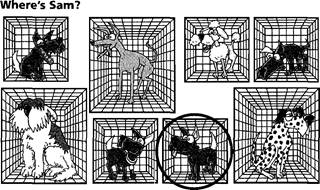
Pages 36 & 37
Eating out: Food in London
Food dishes
1 fish and chips, 2 noodles, 3 curry, 4 cheeseburger, 5 pizza,
Fish and chips: "Open or wrapped?"
If you say 'open' you can eat your chips immediately. If you say 'wrapped'. They will put your chips in paper to keep them warm so you can eat them at home.
Restaurant names
1 Planet Hollywood = American, 5 Wok Wok = Chinese,
2 Masala Zone = Indian, 6 The Chippy = English
3 Yo! Sushi = Japanese, 7 Café Rouge = French,
4 Pizza Express = Italian, 8 Noodle Time = Chinese
At the restaurant
The dish is traditional fish and chips with vinegar.
Who says it?
|
Ready to order? (W) |
Table for two please. (C) |
|
I'm a vegetarian. (C) |
I'd like to pay please. (C) |
|
I'm allergic to nuts. (C) |
Where would you like to sit? (W) |
|
Would you like some |
Can I have another fork? (C) |
|
pepper? (W) Would you like anything to drink? (W) |
I'd like the green salad. (C) |
Pages 38 & 39
Everyday Londoners
Writing home: suggested answers
Dear Mum / Dad
How are you? I arrived in London on Tuesday.
I'm living in a bedsit in Clapham / Kensington. The most difficult thing about living in London is finding a place to live and understanding the transport system.
The best thing about living in London is the nightlife.
Hope you are all well.
I will call you next week Love Anna.
Calling for a job
Gianni is too casual and chatty.
![]()
Suggested answers for Mr Briggs Yes, speaking, How can I help?
Yes, we're still looking for people.
Yes, of course. It's a part-time job. We are looking for somebody who can work evenings from 5pm -1 Ipm, six days a week. It's £550 an hour. Have you got any experience of waiting?
That sounds great We're having interviews this Tuesday at 3pm. Would you like to come?
Pages 40 & 41
The Boat Race
|
|
|
|
|
|
|
|
|
|
|
|
|
|
|
|
|
|
|
|
|
|
|
|
|
|
|
|
|
|
|
|
|
|
|
|
|
|
|
|
|
|
|
|
|
|
|
|
|
|
|
graaaaamaa |
||||||||
|
|
|
|
|
|
|
|
|
|
|
|
|
|
|
|
|
|
|
|
![]() Boat Race statistics
1 fastest,
Boat Race statistics
1 fastest,
2 heaviest,
3 lightest,
5 smallest, ![]()
6 tallest,
7 woman, 8 first,
9 female.
Pages 42 & 43
Wimbledon: The Home of Tennis
Wimbledon rules
1 must, 2 mustn't, 3 must, 4 mustn't, 5 mustn't
Tennis talk
![]()
Pages 44 & 45
Theme Parks Around London
The Tomb Blaster Puzzle
The correct choices spell the words: The Forbidden Kingdom.
Five stars extreme — five stars, intense - four stars, thrilling — three stars, fun for the family — two stars; for little children — one star.
Page 47
The London Aquarium
The correct choices spell out the sentence: More people in the U.S. are killed by bees than sharks.
Pages 48 & 49
London Zoo
The zoo maze couldn't , transferred, arrived, walked, doubled, poked, died, opened, bit, ate, hurried, came, took, bred. The okapi are also known by the popular name of jungle giraffes
Pages 50 & 51
EastEnders
![]()
Pages 52 & 53
The London Marathon
True or false?
2 False. 3 False. You have to be over 18. 4 True. 5 False.
People collecting money for charity run in costumes. 6 True.
Pages 54 & 55
Notting Hill and the Carnival
Party people
1 = She's going to win the costume competition.
2 = He's going to be sick.
3 = She's going to have a headache.
4 = He's going to steal the mobile phone. 5 = He's going to get sunburn.
![]() ©
©
Notting Hill Carnival Route
The carnival is on August the 23rd. The date of the carnival can vary from year to year, but is always on the bank holiday weekend at the end of August.
Page 56
Leicester Square: London Cinemas
Film certificates
U -c, PG -e, 12A- d, 15 - a, 18 - b.
The correct answers in the film star puzzle spell out the name of the film: Love Actually.
Page 57
Music in London
The missing words are:
1 strong, 2 heart, 3 feed, 4 impossible, 5 man, 6 dream, 7 maybe, 8 at, 9 with, 10 you, 11 saves, 12 1'll.
The name of the concert venue is WEMBLEY ARENA.
Page 58
Party in the Park
Who's that girl?
The mystery person sitting next to Prince Charles is Emma Bunton who used to sing with the Spice Girls.
Page 59
The Lord Mayor's Show
The correct figures in the maths problem are:
(Total A): 16, 2, 3, 18, 1757, 65, 43, 200 = 2104. (Total B): 200, 52 = 252. Total A minus Total B = 1852, the year of the Duke of Wellington's funeral.
Pages 60 & 61
Legendary Londoners
Dick Whittington:
The correct choices spell HIGHGATE. This is a region in the north of London, near Hampstead Heath.
Samuel Pepys:
The correct missing words are: seventeenth, diary, marriage, execution, ruled, became, famous, great, people, destroyed, built. The letters in the grid therefore spell out the name: PUDDING LANE.
Sherlock Holmes:
1 These can't be from 221B Baker Street because Holmes didn't play tennis.
2
3 These must be from 221B Baker Street because Holmes played the violin, wore a deer stalker hat, used a magnifying glass, was a fencer and liked chemistry.
4 These can't be from 221B Baker Street because Holmes didn't wear a baseball cap, he didn't like painting and he didn't play football.
Page 62
Cockney Rhyming Slang
Body parts
1 Hampstead Heath = teeth
2 Mince pies = eyes 3 Plates of meat = feet
4 Ham and eggs = legs
5 Boat Race = face
Modern rhyming slang
1 Britney Spears = beers
2 Tony Blair = hair
3 Claire Rayners = trainers
Page 63
The British Museum
1 world-famous,
2 strange-looking,
3 well-preserved,
4 well-dressed,
5 multi-coloured,
6 best-known,
7 hand-carved,
8 unusual-sounding,
9 gold-plated,
10 hard-working, 11 ginger-haired, 12 well-read.
The shaded letters therefore spell 'Rosetta Stone'.
Pages 64 & 65
Hampton Court
The Six Wives of Henry Vlll
1 Catherine of Aragon;
2 Anne Boleyn;
3 Jane Seymour;
4 Anne of Cleves;
5 Kathryn Howard; 6 Katherine Parr.
The Maze
![]()
The wife you would meet in the
maze is Catherine of Aragon, wife number 1 .
Pages 66 & 67
The London Dungeon
The prime suspect
1 is convinced; 2 were carried out;
3 were sent;
4 was signed;
5 was described;
6 was suspected;
7 had been married;
8 was persuaded; 9 had been knighted;
10 to be kept;
11 was called;
12 was found;
13 have been joined.
When all the dots have been joined correctly, they spell out the word: gull. Sir William Gull was the name of the royal doctor who was a possible suspect in the Ripper murders. It is said that he was covering up for the Queen's son.
Page 68
Westminster and the Houses of Parliament
1 about; 2 up; 3 on; 4 at; 5 down; 6 on; 7 on; 8 on; 9 up; 10 at; 11 away; 12 down; 13 after; 14 around; 15 place; 16 up; 17 around; 18 up; 19 place; 20 out.
Page 69
Guy Fawkes and the Gunpowder Plot
The correct choices of verb spell out the name Robert
Catesby
London Parks

Page 71
Art in London
![]()
Page 72
Pubs and Clubs
1 stood, 2 began, 3 agreed, 4 was, 5 smiled, 6 fell, 7 poured, 8 shook, 9 lost, 10 came.
Page 73
Greenwich
Pluto takes 248 years to go round the Sun.
Writers: Sarah Johnson and Jane Myles
Design: Christine Cox
Cover design: Eddie Rego Illustrator: Steve Lillie
Picture research: Emma Bree
Cover photos: Imagestate; A. Meridith / Aviation Library; S. Barbour, J. Watson / Getty Images; Photodisc; Visit London.
Photos: Pages 8-11, 25, 32, 36, 42, 47-49, 71: Hemera. Pages 8-10, 11, 14, 16, 36, 38: Photodisc.
Pages 10, 14-16, 18, 24, 28, 31, 64, 65, 68, 70-73: Visit London. Pages 11 & 14: Imagestate. Page 16: Historic Royal Palaces. Pages 20 & 21: C. Mason, J. McDonald, P. Cole, B. Radford, R. Kinnaird, M. Ashton, S. Forster, C. Brunskill,
S. Botterill / Getty Images; CAFC; CFC; AFC; WHUFC. Page 21: M. Ashton / Empics. Page 22: M. Porro, J. Hale,
T. Aljjbe, M. Mainz / Getty Images. Page 24: S. Finn / Getty Images. Pages 26 & 27: Hamleys. Page 28: S. Touhig / Getty Images. Page 30: C. Lopez / Getty Images. Page 30: C. Newham / Alamy. Pages 31 & 59: Corporation of London. Page 32: Really Useful Theatres; thephantomoftheopera.com; chicagothemusical.com; greasethemusical.co.uk; myfairladythemusical.com; EPO; The Lion King; Fame. Page 34: Battersea Dogs Home.
Page 36: L. Jin / AFP / Getty Images. Page 36: Imagestate / Alamy. Page 38: Image 100. Page 39: Stockbyte.
Pages 40-42: C. Lee, G. Prior, O. Anderson / Getty Images. Page 44: Thorpe Park. Page 45: Chessington.
Page 46: M. Hamblin / Imagestate, Picworks / Alamy. Page 51: BBC. Pages 52 & 53: C. Lee, l. Walton / Getty Images. Pages 54-58: S. Touhig, J. Watson, N. Asfouri, B. Glikas, J. Li, A. Edwards, E. Agostini, F. Brown, J. Furniss, D. Hogan / Getty Images. Pages 60, 69 & 74: Popperfoto / Alamy. Page 61: Lambert / Getty Images. Page 63: British Museum;
E. Bree / MGM. Page 66: London Dungeons. Page 65: F. G. Mayer / Corbis. Page 74: Corbis.
All the Internet sites mentioned in this book have been thoroughly checked by our editors at the time of going to press. However, Internet sites do change content, often without prior notice. Unfortunately, we cannot be responsible for possible subsequent alterations.
Mary Glasgow Magazines (Scholastic Inc.) grants teachers permission to photocopy the designated photocopiable pages from this book for classroom use. No other part of this publication may be reproduced in whole or in part, or stored in a retrieval system, or transmitted in any form or by any means, electronic, mechanical, photocopying, recording or otherwise, without written permission of the publisher. For information regarding permission, write to: Mary Glasgow Magazines, (Scholastic Inc), Commonwealth House, 1 - 19 New Oxford Street, London WCIA INU.
C) Mary Glasgow Magazines, an imprint of Scholastic Inc.,
2004
All rights reserved.
Printed in the UK
Classroom PHOTOCOPIABLE Timesavers
Timesaver London!
(Elementary — Intermediate)
A photocopiable resource for busy teachers
e This book contains a variety of reading texts, activities and games on every aspect of London life — sightseeing, travel, sport, shopping, museums, galleries and, of course, on Londoners themselves. The texts are aimed at young teenagers learning English.
Each activity provides structured language and vocabulary practice, with suggestions for discussion and follow-up pairwork and groupwork.
Topics cover areas as diverse as
Hamley's Toy Shop, Cockney
Rhyming Slang, Party in the Park and London Football Clubs as well as the more historical side of London: Buckingham Palace, Big Ben and the Tower of London.
A free poster-sized map of the capital also comes with Timesaver London! with accompanying ideas for class exploitation.
Level:
Elementary Intermediate
CLASSROOM PHOTOCOPIABLE
Ready-made activities for busy teachers!
Timesavers are a series of supplementary photocopiable materials for English teachers to use with students aged 1 1 years and upwards.
Timesavers save teacher preparation time with a wide range of easy-touse lessons and activities, providing refreshing and motivating ideas for classes at all levels. They are ideal for developing topics, introducing or revising language areas, or supplementing existing course materials.
Timesavers are easy to use! Simply select the activities by language point, activity type or theme and photocopy the pages you need! A full answer key is included.
Here is a selection of some of the latest books to be published in this series.
You can download sample pages from our books from the Teachers' Resource Centre on our website: www.link2englishcom
![]()
FESTIVALS AND SPECIAL DAYS IN BRITAIN
(Pre-intermediate - Upper-Intermediate)
An enjoyable and interactive introduction to British culture with lots of photocopiable exercises and activities. Many traditional celebrations are covered such as Pancake Day, Christmas and Guy Fawkes Night, as well as the more contemporary face of British culture including Ramadan and the Notting Hill Carnival. This book provides a rich and detailed picture of multicultural Britain in the third millenium.
ISBN: 1-900702-40-1
Language Practice
TIMESAVER VISUAL GRAMMAR
(Elementary - Intermediate)
A comprehensive collection of the main grammar points covered at elementary, pre-intermediate and intermediate levels, practised through a series of fun and lively picture prompts. Ideal for consolidation and further practice of recently acquired structures, either in class or for self-study.
ISBN: 1-904720-01-3
TIMESAVER RAPS!
(Elementary — Pre-intermediate)
ELT songs and jazz chants are brought right up to date with 25 cool raps to support lexical and grammatical development. Fun activities extend the language points with a comprehensive index to help the teacher find the right rap.
ISBN: 1-900702-21-5
Материалы на данной страницы взяты из открытых источников либо размещены пользователем в соответствии с договором-офертой сайта. Вы можете сообщить о нарушении.